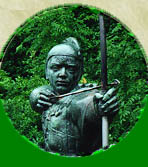|
NEAL ADAMS
Comic Book Artist / Writer / Legend
Artist of Green Lantern / Green Arrow (1970 - 1972)
- Introduction
- Interview Part One: Redesigning Green Arrow and his connection to Robin Hood
- Interview Part Two: Challenging the Comics Code Authority (the drug issues)
- Interview Part Three: Creating John Stewart, Arrow as "The Neal Adams Show" and how to pronounce Ra's al Ghul
- Interview Part Four: Revisiting Classic Covers, Hoods vs. Hats, Green Arrow and Killing, the creation of Merlyn and Ra's al Ghul
- Interview Part Five: Returning to Superman with Coming of the Supermen and also Neal Adams on Batman
- Interview Part Six: Neal Adams on superhero movies, comics as art and conclusion
- Neal Adams and Green Arrow Links
- Order Neal Adams and Green Arrow comics and TV shows
A note to Robin Hood Fans:
You might notice that you’ve strayed a bit from the familiar greenwood paths of Barnsdale and Sherwood. Instead this interview deals with the hero of Star City (or sometimes Seattle or Starling City) – Oliver Queen aka Green Arrow, the modern-day Robin Hood from DC Comics. Neal Adams, the subject of this interview, revitalized the character in 1969 and was the artist of some of the most critically-acclaimed comic books of all time. I hope you’ll stick around to learn more.
Neal Adams Biography:
Born in 1941, Neal Adams is one of the most celebrated artists in comic book history. He illustrated the newspaper comic strip Ben Casey from 1962-1966). In 1967, Adams started working for DC Comics (officially known as National Periodical Publications) with his art appearing on many covers. He also won industry awards for the ghostly superhero feature Deadman appearing in Strange Adventures both as artist (from #206) and writer (from #212).
In The Brave and the Bold #79 (cover dated Sept. 1968) Neal Adams drew a team-up adventure between Batman and Deadman. Adams remained on The Brave and the Bold for the next several issues, drawing Batman’s team-ups with a number of guest heroes. Adams shifted the look of Batman away from the once-popular campy TV series starring Adam West into a more realistic and moody style. For example, he would take scenes written to occur during the day and change them to nighttime to re-establish Batman’s role as a creature of the night. Those subtle changes appealed to fans. In The Brave and the Bold #85 (September 1969) Adams also redesigned the costume of the largely ignored Green Arrow.
Adams moved from the team-up book to draw Batman in Detective Comics, beginning with #395 (January 1970). The issue was written by Denny O’Neil who would become Adams most frequent collaborator for the next few years. Adams (partnered with writers Denny O’Neil, Frank Robbins and Len Wein among others) drew several fondly remembered issues of both Batman and Detective Comics. More film and TV depictions of Batman continue to call back to Adams’ time on the comic. For example, Adams and O’Neil introduced the arch-villain Ra’s al Ghul in Batman #232 (June 1971), who was then played by David Warner in the popular 1992 animated series, by both Ken Watanabe and Liam Neeson in the 2005 film Batman Begins and by Matt Nable in the third season of Arrow.
Also, beginning with issue 76 (April 1970), O’Neil and Adams took over the failing Green Lantern comic book, rebranding it as “Green Lantern co-starring Green Arrow”. They used the comic to explore many of the political issues in America during the late 1960s and early 1970s. Their work garnered both industry awards and attention from the mainstream press.
While drawing some of the most acclaimed DC Comics, Adams also worked on popular runs at rival Marvel Comics including The X-Men in 1969 and The Avengers in 1971-2. He was among the first creators to work at both companies simultaneously without employing a pseudonym.
In 1971 Neal Adams co-founded Continuity Graphics Associates (now Continuity Studios) an art and illustration studio that provides storyboards, animatics, computer graphics, conceptual designs and motion comics for a variety of customers. He is also a champion of creator rights and was instrumental in restoring full credit to Superman creators Jerry Siegel and Joe Shuster and insuring they would receive a pension for their contributions.
In recent years, Adams has returned to some of his most popular comics characters with Batman: Odyssey (2010-12), The First X-Men (2012-13) and Superman: The Coming of the Supermen (beginning February 2016).
The Background of Green Arrow (and related characters):
Green Arrow is a comic book superhero from the company most commonly called DC Comics. (It’s had various official names over the years, but the DC logo has consistently appeared on the cover.) Green Arrow fights crime with a bow and arrow, although his “trick arrows” often have special gimmicks to make them strictly non-lethal (although some comics and TV shows have depicted Green Arrow as a killer).
1941 was the “Golden Age of Comics”. Superman had first appeared in 1938 and several dozen colourful costumed characters were introduced to capitalize on that success. Writer Mort Weisinger and artist George Papp introduced Green Arrow in More Fun Comics #73 (cover date: November 1941). He may have worn a Robin Hood-style costume, but Green Arrow most closely resembled DC’s popular Batman character. Batman was secretly millionaire Bruce Wayne. Green Arrow was secretly millionaire Oliver Queen. Bruce Wayne’s ward Dick Grayson was Batman’s kid sidekick Robin the Boy Wonder. Oliver Queen’s ward Roy Harper was Green Arrow’s kid sidekick Speedy. The similarities didn’t stop there.
Although Green Arrow was the cover-featured character in More Fun Comics for a time, he did not achieve the breakout success of other heroes. However, he was a supporting feature in Adventure Comics and World’s Finest Comics, which were headlined by Superman (or Superboy, his teenaged version) and Batman. So while most superhero characters stopped being published in the late 1940s, Green Arrow’s features continued an unbroken run into the superhero revival of the 1960s. However, by the mid-1960s Green Arrow only regularly appeared as a member of the superhero team the Justice League of America.
As you’ll read in the interview below, Neal Adams redesigned Green Arrow’s costume in 1969 to highlight his Robin Hood traits. Justice League of America writer Denny O’Neil continued this trend by having an evil businessman frame and bankrupt Green Arrow’s alter ego Oliver Queen. He was no longer a billionaire like Batman, but instead had developed an interest in the plight of the downtrodden.
Green Arrow was made the co-star of the Green Lantern comic in issue 76. Green Lantern was Hal Jordan, a test pilot who was recruited for an outer space police force known as the Green Lantern Corps. Each member of the Corps was assigned to protect a sector of space. The Green Lanterns used “power rings” which enabled the wearer to fly, form solid objects out of green energy and perform other great feats. Green Lantern was essentially a cop. Green Arrow had been re-positioned as a socialist rebel. Through their unlikely friendship these two heroes explored the political issues of the time.
The original Green Lantern / Green Arrow run (issues 76 -87. 89) may have been brief, but they are some of the most-reprinted comics of all time. (The paperback reprints of the 1990s labelled this run as “Hard-Traveling Heroes”, a phrase that fans continue to use.) Green Arrow was rescued from obscurity and starting in the 1980s was the solo feature in his own comic books. He is also the lead character in the TV show Arrow which began in 2012 and stars Stephen Amell as Oliver Queen
This
interview was conducted by phone on February 7, 2016.
Interview Part One: Redesigning Green Arrow as a modern-day Robin Hood
AWW: Hello, is this Neal Adams?
NA: This is indeed Neal Adams.
AWW: Hi, this is Allen Wright calling from the Robin Hood site.
NA: How ya doing?
AWW: I’m doing fine. Thank you very much for your time.
NA: A pleasure.
AWW: So, where to start, maybe we should start with Green Arrow since that’s sort of the Robin Hood connection and you helped re-design his image by giving him that goatee in The Brave and the Bold (issue 85).
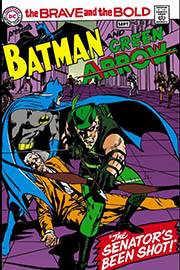 NA: Well, that’s true. I was doing a series of comic books called Brave and the Bold, and I was told that the next character we were going to team up with Batman was Green Arrow. And of all the characters that I was teaming him up with, I kind of rebelled at that because as I told my editor Murray Boltinoff outside of the fact that he’s just a copy of Batman he’s a dull and boring character. And so Murray said “Well, you want to change him?” Ha, well sure. I said let’s try to get him away from what he was and see what we can do. So, my writer, Bob Haney, gave us the opportunity to change him to the extent we changed his costume. But you know, that was enough for me. NA: Well, that’s true. I was doing a series of comic books called Brave and the Bold, and I was told that the next character we were going to team up with Batman was Green Arrow. And of all the characters that I was teaming him up with, I kind of rebelled at that because as I told my editor Murray Boltinoff outside of the fact that he’s just a copy of Batman he’s a dull and boring character. And so Murray said “Well, you want to change him?” Ha, well sure. I said let’s try to get him away from what he was and see what we can do. So, my writer, Bob Haney, gave us the opportunity to change him to the extent we changed his costume. But you know, that was enough for me.
I realized that if Green Arrow was going to get away from being an imitation Batman – you know he had an Arrowcar, he had Speedy [Green Arrow’s sidekick] and of course he had those seats in the Arrowcar that would launch himself up two storeys and land safely and not smear himself all over the roof of a small building. If we could get rid of that stuff and basically turn him into a modern-day Robin Hood, then well, you know it’s one thing to be an imitation Robin Hood which isn’t kind of bad, but a bad thing to be an imitation Batman.
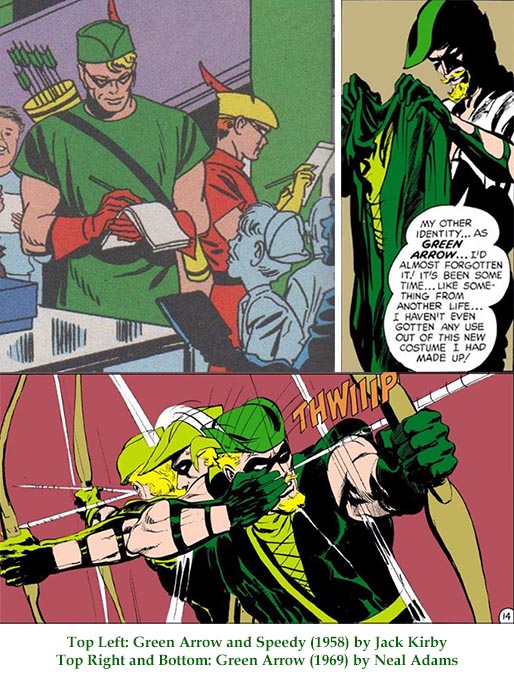
He was blond-haired so that gave me the opportunity to give him a blond beard. I made his outfit be a little bit more of an archer’s outfit that I gave him leather protectors on his arms, I gave him a triple quiver so that it would mould to his back. Of course, the question of whether or not old archers ever used the quiver on their back has been brought into question currently, because it doesn’t make any sense. You can’t really move around with a quiver on your back. But I did. You know, I’ve had some experience with archery.
So, I made a character that I felt was more of a modern-day Robin Hood and that is what Green Arrow became.
AWW: And when you did that, what was the reaction? I know even before the Green Lantern/Green Arrow series that look was picked up for a few issues of Justice League by writer Denny O’Neil and Dick Dillin was the artist. Is that something that the Justice League editor Julie Schwartz talked about with you when you changed the look? [
NA: No, not really. Essentially it was very clear that that character in Brave and the Bold was something that everybody liked. They just loved the character. I mean it was what are we going to do with this character? We have him, he hasn’t got a book,you know, let’s use him somewhere. So Julie tried to use him, and then when the opportunity came for me to do the Green Lantern book which was on the verge of cancellation, Julie came up with the idea of teaming him up with Green Arrow. Which seemed to be a stupid idea at the time, I mean Green Lantern and Green Arrow that’s kind of silly when you think about it. Yet it actually turned into a really good story.
Listen to a sound clip of the next section.
He [Green Arrow] had lost his fortune, so he was kind of living on the edge of civilization in Harlem or close to Harlem. He was like, you know, Robin Hood in the woods. Made a lot of sense to me, and I liked the character. I liked the juxtaposition of himself against Green Lantern. But really it all came about because people just loved the look of the character. It struck that chord.
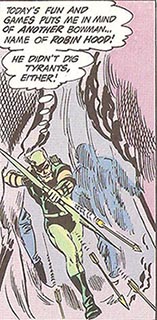 Now you know you have to understand that I cheated. I didn’t create a great new character that everybody immediately related to. I essentially created a modern Robin Hood and everyone relates to Robin Hood. What’s the difference? He’s got a little mask on his face. Big deal. He’s a modern-day Robin Hood. So, everybody had that picture in their mind. They did not have the old Green [Arrow] picture in their mind – that guy with the green outfit and the Arrowcar and the rest of that. Robin Hood is part of myth. To create a modern-day Robin Hood was so clear and obvious. Also to create, I mean I know you must have seen the Errol Flynn movie a dozen times or more, but this idea of the smiling outlaw with a grin on his puss and defying everybody was very attractive to me, and was attractive to everybody. I mean you know we’re waiting on the TV show [Arrow] for that guy to crack a smile once in a while. And he is actually starting to do it. I think that we're discovering that he possibly could be -- in fact I don't think I'm spilling the beans, but that character played by that actor is going to be in some other show as a kind of a guest and he's going to have the beard. [Stephen Amell's Green Arrow appeared in the February 25, 2016 episode of the spinoff series DC's Legends of Tomorrow. The heroes of the spin-off are time travellers and they encounter Green Arrow thirty years in the future, by which time he has grown a comic book styled beard.] Now you know you have to understand that I cheated. I didn’t create a great new character that everybody immediately related to. I essentially created a modern Robin Hood and everyone relates to Robin Hood. What’s the difference? He’s got a little mask on his face. Big deal. He’s a modern-day Robin Hood. So, everybody had that picture in their mind. They did not have the old Green [Arrow] picture in their mind – that guy with the green outfit and the Arrowcar and the rest of that. Robin Hood is part of myth. To create a modern-day Robin Hood was so clear and obvious. Also to create, I mean I know you must have seen the Errol Flynn movie a dozen times or more, but this idea of the smiling outlaw with a grin on his puss and defying everybody was very attractive to me, and was attractive to everybody. I mean you know we’re waiting on the TV show [Arrow] for that guy to crack a smile once in a while. And he is actually starting to do it. I think that we're discovering that he possibly could be -- in fact I don't think I'm spilling the beans, but that character played by that actor is going to be in some other show as a kind of a guest and he's going to have the beard. [Stephen Amell's Green Arrow appeared in the February 25, 2016 episode of the spinoff series DC's Legends of Tomorrow. The heroes of the spin-off are time travellers and they encounter Green Arrow thirty years in the future, by which time he has grown a comic book styled beard.]
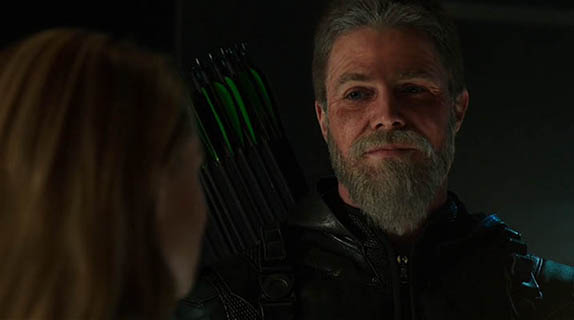
AWW: It's always strange to me now when they go back and do a Green Arrow without the beard, even though that's how he was for nearly the first 30 years of his career. The look you gave him is so iconic and the one they always go back to.
NA: But it's really a rip-off of Errol Flynn to be perfectly honest. I mean it's not Errol Flynn in that I kind of modelled him after a little bit after myself and I have a little bit of a square, kind of Irish face, and Errol Flynn has a little bit more of a Nordic long face, but so what? You know, it's still that smiling, devil-may-care character. Thar's what Green Arrow is. Of course on the show he cares about everybody and he takes the weight of the world on his shoulders. But think every once in a while we see that smile blossom forth and I think we're going to see a slightly different character.
AWW: Something else I always liked with what you did with him, besides the smiling, is he had an anger -- a different kind of anger than Batman's anger.
NA: Well, it's a very emotional and loud anger. He lets you know pretty much. Batman seethes and is quiet and goes about his business. But Green Arrow, he just lets you know.
AWW: Growing up in the 70s, and little after your run, but having seen all the things that called back to it, he's a very distinctive character. He looked unlike any other superhero in comics, he had the relationship with Black Canary that was unlike any superhero.
NA: Let's be honest, he's not really a superhero per se. He's a hero. He doesn't have any superpowers, he wasn't bitten by a radioactive sparrow or anything. He just depends on himself. He's an independent character. So, I would call him a hero rather than a superhero. I mean we're so used to calling these characters superheroes these days. But one of the reasons he was such a good character and remains a good character is that he is not a superhero. He's a hero.
AWW: Besides Errol Flynn was there any Howard Pyle in that look? I think of that just because Pyle's Robin Hood was blond too.
NA: I only found out about Pyle later to be perfectly honest. I did not get to see those illustrations -- I wish I had, although I doubt it would have made that much of a difference. But looking at Howard Pyle's stuff, no matter what is always a good thing. Essentially I just said I want to change the character, I want to make him a modern-day Robin Hood. How simple a concept is that? It's as simple as can be.
AWW: Also the shape of his face was different than most superheroes.
NA: Yeah, I would say that, but I do that with heroes in general. I'm really not happy with these bulky heroes. I like athletic heroes who are able to jump and run and do things. Some of these heroes I can't imagine them running down a block without being winded. They seem so bulky.
AWW: When you were doing the Green Lantern/Green Arrow series with Denny O'Neil you were at the time just when the Comics Code was starting to change.
NA: I think the Comics Code wasn't going to change. I think we changed it.
AWW: I noticed that the early Comics Code from the 50s was very much "authority had to be respected". And when it changed in 1971 during your run, they put this proviso in that okay, authority could be bad if they were shown to be bad apples and punished.
NA: Yeah, a little bit. But the Comics Code, if you read the Comics Code, you are really not supposed to cast aspersions on federal, state or local government officials or you know, anybody that's in any government office. They are not supposed to be thought of as being bad, and that was part of the Comics Code. So we kind of snuck around that. People that we made fun of were not official members of the legislature -- businessmen. Businessmen weren't off the platter there. They we could go after.
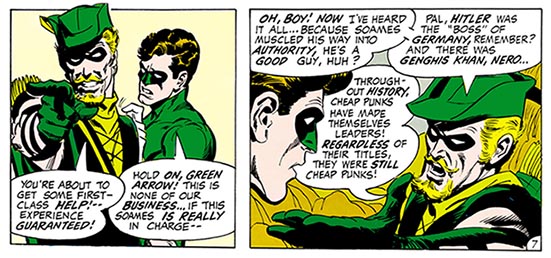
You have to understand that the guy who ran the Comics Code, I forget his name -- very nice fellow, a lawyer, his job was to take the Comics Code that was created by the publishers - I mean, you must understand it wasn't created by any government office, it was created by the publishers to be a self-protective, self-governing agency and set of rules, which is sometimes the very worst you can do. I'm mean, oh yeah, we'll self-govern ourselves into oblivion. And that's sort of what they were doing. This guy who was writing the Comics Code, he just looked at the stuff that passed in front of his eyes, and looked at the Comics Code to see whether or not it was being followed. I found myself not going up against the Comics Code because I'm one of those people who walk between the raindrops.
If I find I can't do vampires, okay, so what I'll do is take a pterodactyl -- I'll infect somebody with a pterodactyl -- and I'll have it suck energy from other people. And he's in effect a vampire because if you suck blood, you suck energy. But since he wasn't sucking blood, he was sucking energy -- The character was Sauron who I did for Marvel [in X-Men #59-61 in 1969] -- then you couldn't accuse me of doing a vampire. But the very same result existed. He would grab the person or even a dog by the head, absorb his energy and the person would either stumble off and look old and look terrible and tired, or die. So, in effect he was a vampire, using the pterodactyl, the pterodon, I had a leather-winged creature, not unlike a bat. So the analogy to a vampire was dead on, but he wasn't a vampire so the Comics Code had to let it go through. [The outcry that led to adoption of the Comics Code in 1952 was, in part, a reaction to the then-popular horror comics. A provision of the original code was "Scenes dealing with, or instruments associated with, walking dead, torture, vampires and vampirism, ghouls, cannablism, and werewolfism are prohibited." Vampires were allowed in the 1971 revision.]
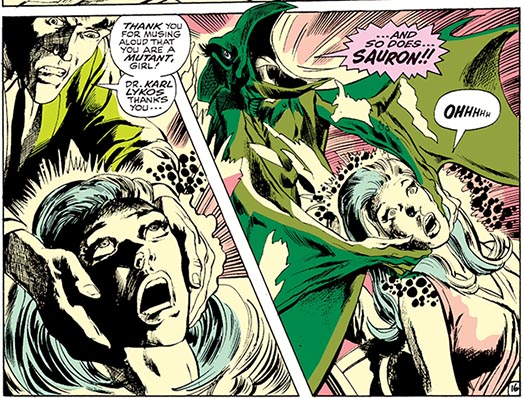
AWW: And with Sauron's real name, wasn't it Lykos which implies a werewolf?
NA: Right, it implies wolf. We kind of threw that in there. But basically it was Sauron, who essentially was in Tolkien. That was where Roy Thomas (the writer) got his name. You see, by doing that, I was doing a vampire story -- 100%. And the Comics Code -- I got to know the guy who ran the Code, that's why I'm a little embarrassed I don't remember his name, I liked him. He was a nice guy. He was doing his job. And I never really had any conflicts. I just found ways of getting by, doing things that you couldn't easily otherwise do, unless you're clever. So, I clevered the stuff by, and I really never got any notes back from him saying "you can't do that". Maybe once in a while -- once here, once there -- a little too much violence, "don't put blood on the person's face" or something. And I got by, so I was very much a friend of the Comics Code, but I'll tell you underneath it all, I was seething, seething, to get ride of that damned Comics Code. I don't believe in those sorts of things, whether it's self-governing or not, it's against the tradition of America. So you know, it's one thing to put warning things on comic books if they tend to be adult and perhaps shouldn't be read by kids, but to forbid, that's really not good at all.
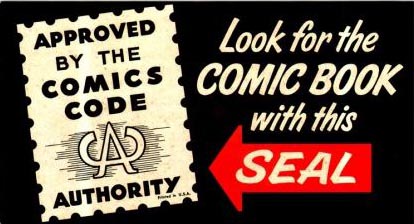
So one day when I realized that Denny O'Neil and I were probably coming to the end of the line with the Green Lantern / Green Arrow books, because one they weren't selling well. Or else the perception was that they weren't selling well, but in fact what was happening was there were teenagers all over America that were buying comic books out of the back of the wholesalers, and those books were being called destroyed, because the industry had gotten into doing this 'affidavit return' policy. So that they didn't have to return the [unsold] books or even slice off the titles. They would just depend on the local distributor to say they had destroyed the comic book. Well, local distributors were not destroying the comic books, they were selling them to teenagers out of the back of the distributor's shop for seven cents [cover price was 15 cents]. And these kids would then take those comic books by their favourite artist -- or the artist that would sell like Berni Wrightson and myself and Barry Smith and all those folks and they would sell them to their friends at motels or in their father's garages. Sell them to the neighbourhood kids for two dollars and five dollars according to what the quality was, because those kids could not find those comic books in their neighbourhood, because these kids were buying up them up out of the back of the wholesaler. And those kids who did that became the first tier of direct sales market comic book stores.
AWW: Which is what industry is today.
NA: That's right. Those guys are still around. Not all of them, many of them died. You just have to look at the guys wearing the jeans jackets and silver hair with pony tails and leathery skin and those are the guys that began the direct sales market by buying comic books out of the back of the wholesalers and the wholesale reporting them as being destroyed. So when DC Comics said "Gee, I don't understand, Neal. Everybody's writing letters about Green Lantern/Green Arrow, everybody loves it, college students are writing letters, high school students are writing letters, but it's not selling that well. I don't understand." Well, it was selling like hotcakes -- like hotcakes. I sign, when I go to conventions, mint condition copies of those books. Because people put them in boxes and store them away and sell them. You can buy those books for as much as $400 a copy now. You've got very smart people who are storing that away or selling them for $2 or $5 in those days. It was a very corrupt and very strange business, and the direct sales market -- the no-return market -- saved it, but they saved it because they had corrupted it.
AWW: That's funny that the corrupting influence becomes the official saviour.
NA: That's right. Anyway, it was very clear we were coming to the end of our run. Denny wrote a story on overpopulation. And I thought "Unh-unh, this is the end. This is not a good story. We don't want to do this." You could fit the population of the Earth into the state of Texas and have room for everybody. It just was a bad subject. I remember those days. People were having vasectomies and all kinds of weird s--t was going on. So, I figured I'm watching the end of what we're doing. And I thought there's two things we didn't do, first we didn't get a Black superhero and I was determined to do that. Second, we hadn't handled drugs. And therefore, we had to kill the Comics Code, because that was the only way to do drugs. So I went home and, on my own, pencilled and inked and then lettered that first drug issue [cover] with Speedy [Green Arrow's former sidekick aka Roy Harper] as a junkie. And I handed it into my editor and he dropped it like a hot potato and said "What the hell are you doing, Neal? You're causing trouble again." I said "No, we oughta print this, Julie [editor Julius Schwartz]." He said "We'll never print this, it won't pass the Comics Code." He said, "First of all, Neal, this will never be printed -- never be printed -- and second of all, I will never pay you for it." I said "We'll see."
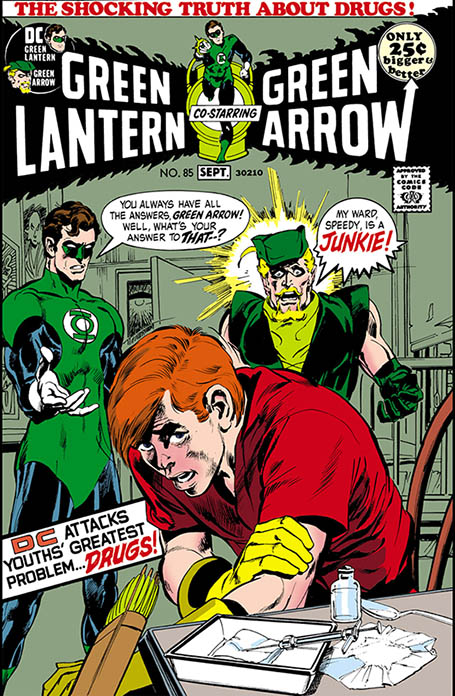
So, it sat on his desk for a couple of months. In the meantime, over at Marvel, Stan Lee [writer and co-creator of Spider-Man] had done an issue of Spider-Man where [Harry] Osborn or somebody like that takes some pills and walks off a roof or something. [Amazing Spider-Man #96-98, cover dated May-July 1971 although the first issue went on sale in early February 1971. The issues were drawn by Neal Adams' predecessor on Green Lantern, Gil Kane.] And of course Stan really didn't much about drug addiction. Mostly guys who did pills like that would go off into the corner, sit in the corner and ask people stay away from them -- or get very happy. So, it wasn't exactly like Stan was a big drug advocate.
Denny O'Neil and I both had studied the drug problem through Phoenix House and we were both going to a book for the city of New York on drug addiction, so we really became steeped in it. I was also the head of our neighbourhood committee for our local drug institution in the Bronx. I was the head of the citizens' committee that kept the neighbourhood safe from the junkies, and kept the junkies safe from the neighbourhood. So I have had quite a bit of experience in this drug addiction problem.
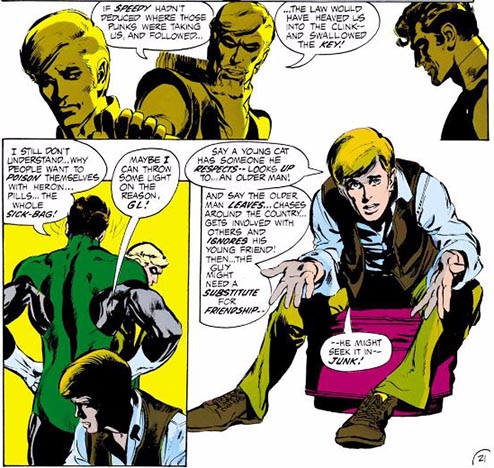
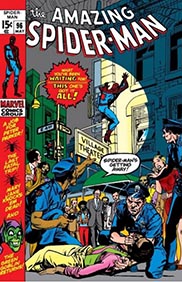 I went to talk to Johnny Romita [a key Spider-Man artist and inker on the drug issues] and said "What the hell's going on, Johnny?" He said "Well, Stan went to his uncle, Martin Goodman, and he said 'the Comics Code sent this book back and now I still want to publish it, but I'd have to publish it without the Comics Code seal and I'd like to do that.' And his uncle said 'Sure, go ahead.'" So, they did and a week later I went back to Marvel, I was pretty welcome at Marvel, and talked to Johnny and I said "What happened with the book?" He said "Nothing. Nothing happened." I said "What do you mean nothing happened?" He said "Nothing. Nobody even noticed the Comics Code seal wasn't on the book." "Really? Are you kidding? Nobody noticed, nobody wrote a letter, no phone calls, nothing?" "Nothing," he said. "Nothing happened. Nobody cared." Well over at DC Comics they cared. They were having a f---ing conniption, they were going ape s--t. Because they had this cover on their desk for a couple of months and they didn't do anything. So within a week the publishers had a meeting of the Comics Code Authority and they basically took all the teeth out of the Comics Code. In about four days. And a week later, Julie Schwartz came to me and said "We're doing that book," and I said "So, you're going to pay me for that cover. Right, Julie?" He said "Get out of my room." I went to talk to Johnny Romita [a key Spider-Man artist and inker on the drug issues] and said "What the hell's going on, Johnny?" He said "Well, Stan went to his uncle, Martin Goodman, and he said 'the Comics Code sent this book back and now I still want to publish it, but I'd have to publish it without the Comics Code seal and I'd like to do that.' And his uncle said 'Sure, go ahead.'" So, they did and a week later I went back to Marvel, I was pretty welcome at Marvel, and talked to Johnny and I said "What happened with the book?" He said "Nothing. Nothing happened." I said "What do you mean nothing happened?" He said "Nothing. Nobody even noticed the Comics Code seal wasn't on the book." "Really? Are you kidding? Nobody noticed, nobody wrote a letter, no phone calls, nothing?" "Nothing," he said. "Nothing happened. Nobody cared." Well over at DC Comics they cared. They were having a f---ing conniption, they were going ape s--t. Because they had this cover on their desk for a couple of months and they didn't do anything. So within a week the publishers had a meeting of the Comics Code Authority and they basically took all the teeth out of the Comics Code. In about four days. And a week later, Julie Schwartz came to me and said "We're doing that book," and I said "So, you're going to pay me for that cover. Right, Julie?" He said "Get out of my room."
AWW: He sounds like quite a character from all the interviews and articles I've read.
NA: Oh, Julie? Absolutely. Are you kidding? The best. The best and the worst all wrapped in one guy. Curmudgeon. And the weird thing is that Julie started off as a teenager acting as agent for science fiction writer. He and -- uh, what's the name of the other guy who was Superman editor.
AWW: And the co-creator of Green Arrow, Mort Weisinger
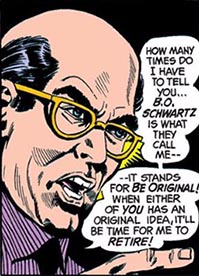 NA: Yeah, Mort. The two of them started as teenagers. It occurred to them that science fiction writers weren't being represented so they offered their services as teenagers to represent and take science fiction stories to the various publishers and represent them. And they began a business as agents. I mean Julie Schwartz represented Ray Bradbury for God's sake, Silverberg and all those guys. So they began very young. I don't know how they became quite so curmudgeonous as they got older. But still they recognized talent and ability. They may have been kind of jerks and a--holes in their way, but they were for good quality material and seeing that talented people got pushed forward. I remember Julie Schwartz bitching about Gil Kane [the original artist on Green Lantern] all the time, but he used him every month. And he practically cried when Gil had to leave and go off and do his own stuff. I wouldn't say practically cried -- bitched and moaned and yelled is more like it. Let me tell you my favourite quote of Julie Schwartz. You have to understand that Julie was an intellectual and very sensitive to people's wants and needs, so my favourite quote of Julie Schwartz is "Get the f--- out of my office, Adams!" My favourite quote. NA: Yeah, Mort. The two of them started as teenagers. It occurred to them that science fiction writers weren't being represented so they offered their services as teenagers to represent and take science fiction stories to the various publishers and represent them. And they began a business as agents. I mean Julie Schwartz represented Ray Bradbury for God's sake, Silverberg and all those guys. So they began very young. I don't know how they became quite so curmudgeonous as they got older. But still they recognized talent and ability. They may have been kind of jerks and a--holes in their way, but they were for good quality material and seeing that talented people got pushed forward. I remember Julie Schwartz bitching about Gil Kane [the original artist on Green Lantern] all the time, but he used him every month. And he practically cried when Gil had to leave and go off and do his own stuff. I wouldn't say practically cried -- bitched and moaned and yelled is more like it. Let me tell you my favourite quote of Julie Schwartz. You have to understand that Julie was an intellectual and very sensitive to people's wants and needs, so my favourite quote of Julie Schwartz is "Get the f--- out of my office, Adams!" My favourite quote.
AWW: When you did the drug issues, how was that plotted? You and Denny O'Neil together?
NA: No, think about this, look at that first cover, and try to imagine not being able to write that story. It's pretty much there, isn't it? How hard is that story to write?
AWW: I think I heard somewhere about an earlier version of the cover where the needle is actually going into Speedy's arm?
NA: Not at all. The cover is actually the way I drew it. Because I'm not so dumb to do that. It's one thing to -- I mean I put the fixes in the damn butcher's tray. I mean that everything. I had the rubber tubbing, I had the needle, I had the cotton. I had the heroine sitting right there in the plastic paper. I mean everything was there. No doubt about it. I remember in the book there was an objection to where he tied the thing around his arm and tightened it up and was going to do it. And we were asked to change that and just hold the tube and don't do it because it acted as an instruction. Which I had to agree with. It does. I mean like, you know, "Step number one, do this, Step number two do that." Yeah, that was stupid. So we just took the tube off his arm and had it hanging there. No big deal. And they were right. That was the new Comics Code, just don't instruct kids on how to do heroin. It makes sense, I'll buy that.
AWW: They were powerful issues. Not just with Speedy doing drugs, but his relationship with Green Arrow.
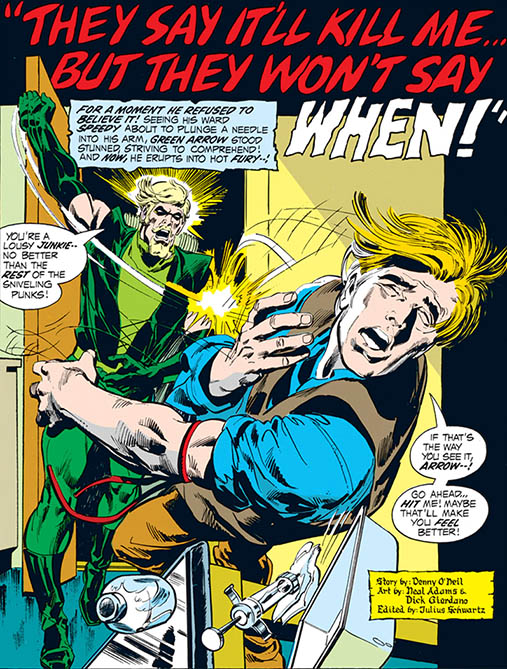 p>
NA: I have to say. And remember when Arrow socks Speedy in the kitchen? There is something I did to interfere with the writing on that book I will tell you. I don't want to make a thing of it. Maybe I shouldn't say. Anyway, I wrote the last two pages because it just seemed to end not doing anything. You want an idea of what my writing is a little bit like, read the last two pages of the second book.
AWW: It's a funeral for one of the victims right. And Green Arrow tells Speedy something like "you've done well," and Speedy is not exactly happy with that.
NA: He socks him. And then gets pissed and does his little speech. Yeah, it's a good two pages. The problem was that Denny had finished the story -- I shouldn't talk -- don't worry about it. Drop it. Denny did a great job. It just wasn't quite as dramatic as it should have been.
AWW: That's why it's a collaboration.
NA: Yeah. Overall Denny did a fantastic job. Maybe except for that overpopulation issue. [Laughs] He did a great job on John Stewart as well. He turned in a great script. That was a little bit of a battle. It was actually quite a dramatic battle I had with Julie on that. If you'd like to hear I'd be glad to tell you.
AWW: Absolutely.
NA: I went to Julie's office and I said "Julie, there oughta be an assistant Green Lantern. You know, in case something happens to Hal Jordan." He says "We already got that." I said "Whadda you mean?" He said "There's this guy, Guy Gardner, and he's like an assistant if something happens to Green Lantern." I said "I'm sorry, Julie, I don't read the comics, so I don't know what know you're talking about." So he pulled out his bound volumes of comic books and opened it to the story that had Guy Gardner in it. And it turns out that Guy Gardner is this white, Anglo-Saxon, Protestant gym teacher in the midwest. So I said "Okay, Julie. This is what I suggest. We hit him with a bus." Julie said "What?" I said "I think we should hit him with a bus." Julie said "Why would you want to do that?" And I said "Well, if you break his arm he's just going to come back in a month and a half, but if you hit him with a bus he's going to have internal injuries and all kind of stuff you know. He'll still be alive, but it will be a long time before he's back."
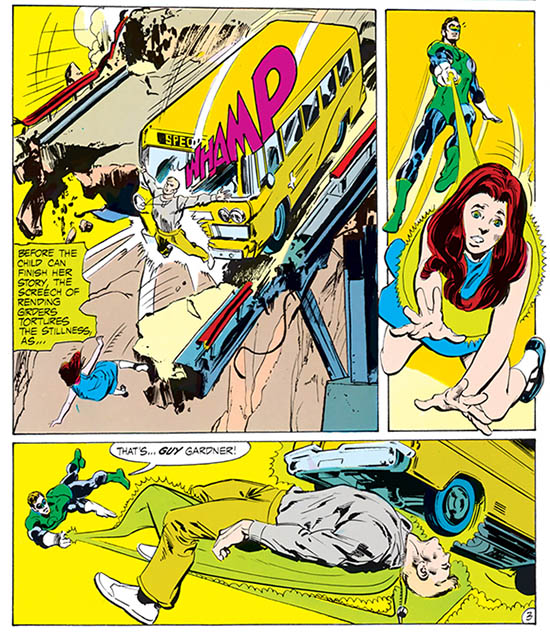
Julie said "Why do you want to do that?" I said "Well, I think we'll have another Green Lantern." He said "Why?" I said "Well, I'm going to tell you why. This alien comes to Earth and he's going to die. So he sends the ring out to find the bravest, most worthy guy on Earth to be the next Green Lantern. Turns out to be a test pilot [Hal Jordan]. I can buy that. Test pilots have balls of steel. I would never test a plane. Never happen. So, I'm buying that. Okay. I'm good okay.
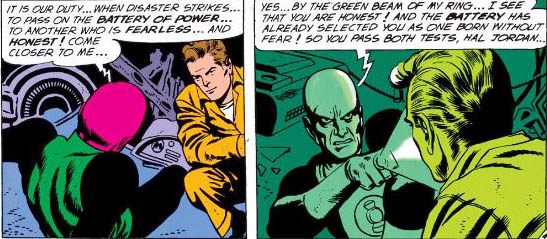
So now the ring is going to go find somebody to replace him when something happens to him. So the ring goes out, passes by Batman, passes by Superman, all the heroes in the DC and Marvel Universe, and finds a white Anglo-Saxon gym teacher. I just find that a little incredible. I don't get it," He says "Well, what do you want?" "How about we have, I don't know, a Black guy? Or an Asian." "You start trouble." I said "Okay, Julie, you watch the Olympics?" He says "I watch the Olympics." I say "Well, okay, how often do you see three white guys up there?" I said "You usually see Black guys and white guys and Asian guys. You rarely ever see three white guys. You know, maybe in shot-put or archery. But you know, pretty much, you get a mix. I just find it hard to think that the ring is going to go out and find another Protestant white guy. I don't know why."
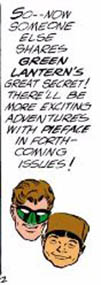 He says "Well, how about we make it an Asian?" I said "Well, okay, Julie, you don't have a really good record with Asians." He said "What do you mean?" I said "Well, you had a character for ten years who's an Asian who is a friend of Hal Jordan. And you called him Pieface." I said "Do you understand how insulting that is?" He says "We didn't -- I didn't mean that as an insult." "Julie! Pieface! I'm sorry, it's like Chop-Chop, you know? Pieface!" I said "Is it insulting? Ask any Asian! Pull somebody off the street and say 'What would you think if somebody called you Pieface?' Punch you right in the face. It's stupid!" He says "Oh, you want a Black Green Lantern, don't ya?" I said "Am I that shallow, really, that you can see through me that easily? Like a puddle in the street? Yeah, I'd like to have a Black Green Lantern." He says "Well, you're going to have to draw him." I said "Julie, not am I going to have to draw it, I'd better draw it, because as far as I know I'm the only guy in comic books that can draw Black people. I mean even the Black artists draw white people when they draw Black people. Because nobody lets them do it right. Or they've been trained by other people to draw everybody looking white and then put a little extra colour on them. I know how to draw Black people. I know how to draw Asians. I know how to draw." He says "Well, you're going to have to do it." "I said fine. Okay, you got a deal." He says "Well, how about we make it an Asian?" I said "Well, okay, Julie, you don't have a really good record with Asians." He said "What do you mean?" I said "Well, you had a character for ten years who's an Asian who is a friend of Hal Jordan. And you called him Pieface." I said "Do you understand how insulting that is?" He says "We didn't -- I didn't mean that as an insult." "Julie! Pieface! I'm sorry, it's like Chop-Chop, you know? Pieface!" I said "Is it insulting? Ask any Asian! Pull somebody off the street and say 'What would you think if somebody called you Pieface?' Punch you right in the face. It's stupid!" He says "Oh, you want a Black Green Lantern, don't ya?" I said "Am I that shallow, really, that you can see through me that easily? Like a puddle in the street? Yeah, I'd like to have a Black Green Lantern." He says "Well, you're going to have to draw him." I said "Julie, not am I going to have to draw it, I'd better draw it, because as far as I know I'm the only guy in comic books that can draw Black people. I mean even the Black artists draw white people when they draw Black people. Because nobody lets them do it right. Or they've been trained by other people to draw everybody looking white and then put a little extra colour on them. I know how to draw Black people. I know how to draw Asians. I know how to draw." He says "Well, you're going to have to do it." "I said fine. Okay, you got a deal."
Click link to play a sound clip from the next section.
I said "Before you hand out this writing task, there's just one thing - okay? I don't want a gangbanger who suddenly gets a superpower and turns into a good guy. I don't want an African chief that everybody can relate to, because I can't. And I don't know any Black guys on the street that can relate to an African chief. I want a college graduate. I want him to have a profession. And I want him to be a good, tough guy." "Oh yeah? Fine."
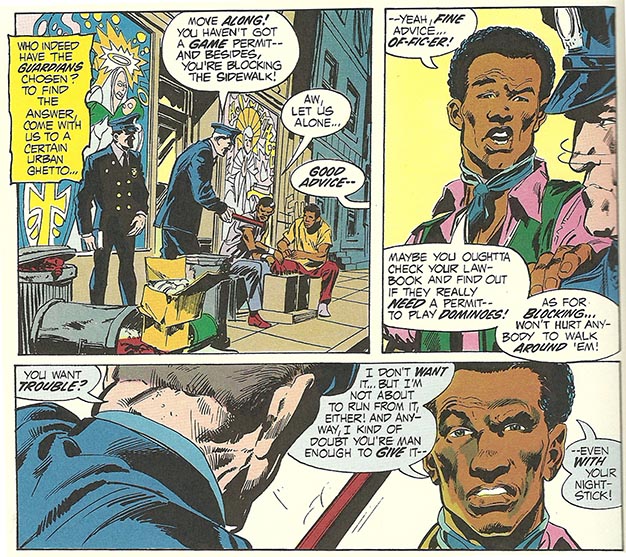
Anyway, he gave the assignment to Denny O'Neil. So, Denny gives me the script and I read the first page and sure enough he's a college graduate, he's an architect, he's a tough guy, doesn't put up with s--t. His name is Lincoln Washington. I'm reading it and I go look for Denny. And "Denny, Lincoln Washington?" Denny says "Not me. It's not me. That's Julie. Julie's name." Okay, so I go to Julie's office and I close the door because there's gonna be some yelling and I say "Julie, Lincoln Washington!" "What? I know lots of guys with names like that!" "Yes, Julie, and they're all changing their names because that's a slave name! That is a slave name, Lincoln Washington! Dontcha -- Julie?" He says "Well, you know, you pick a name." I said "Any name. Put a bunch of names in a hat and pull some names out and you've got a name." He says "No, no, no. You don't like my name?" I said "It's not that I don't like your name. You want to fill this office with letters? Lincoln Washington? There are people changing their names every day. They don't want slave names." "You pick a name." "I said, okay, fine. John Stewart." How would I know he'd become a late night comedian?
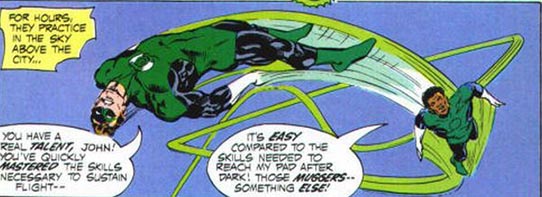
So, this story has two endings. One happened fairly recently. One happened back then. I'll tell you the recent one. The recent one is that they announced they were going to have a Green Lantern movie, and it's going to be Hal Jordan -- Green Lantern. And all the kids in America go "Who the hell is Hal Jordan? Hal Jordan -- who is that?" "Oh, it's Green Lantern?" "John Stewart is Green Lantern. What the hell are you talking about? Everybody knows that. Are you stupid? Hal Jordan?" Somehow DC Comics and Warners equated selling 70,000 comic books a month to 10 million people watching a cartoon show on Saturday morning. Somehow that would over-balanced it so everybody would know. So, of course, they lost a hundred and fifty million dollars. It's a figure that lies in my head like a stinking piece of s--t -- 150 million dollars. Really? Wow. Lot of money. Lot of money to lose. John Stewart better be in the next movie. Just saying.
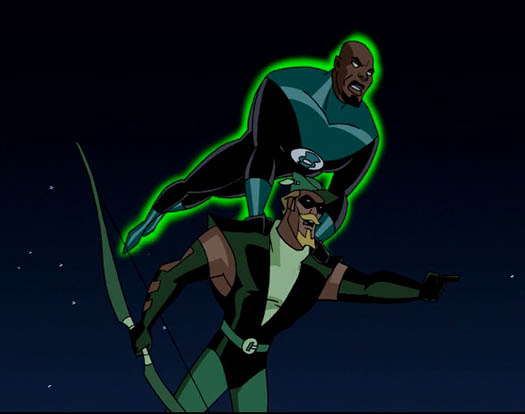
The second ending of the story happened very close to doing the book. So I did the book and I handed it in. And I coloured it. Back in those days when you coloured comic books you had to mark your colours. You would number them. So Anglo-Saxon flesh would be Y2R2. That's 25% yellow, 25% red. Black people they usually did like a khaki -- a light brown. It was like YR2B2. s--t brown. It looks like baby s--t. And they coloured all Black people that way. So I didn't, of course. I coloured John Stewart dark brown. I handed the job in and I marked it. YR3B2 -- that's going to be dark. So I handed the job in, and I'm up at DC working on some covers and s--t. And Julie Schwartz and Sol Harrison - this was what was so great about living amongst liberal Jews. They really are defenceless, because what can they say? They are Jews; they have to be the most liberal guy there. So, how can Neal be more liberal than they are? It's not right. "I'm a liberal." "Yes you are, you're practically a socialist, Julie." "That's right." So they come down the hall and nobody's there but me. So Sol comes and says "Neal, I noticed that you coloured the John Stewart guy kind of a darker brown." "Yeah." "Well, we usually colour Black people a little brown." "Yeah, I noticed that. In fact over at Marvel they colour this character Gabe in the Howling Commando's grey. Y2R2B2 - grey." "Yeah, but are you sure you want to have him that dark?" "Well.... yeah. Most Black people I know are pretty dark. There are some very light-skinned people, but not John Stewart." Now I'm going to say something that they say that's going to be a direct quote. You have to understand it's a direct quote, and after you hear it you'll go "Really? Nobody would have said that. Nobody human would have said that." But still you have to remember the times we were in. Okay?
AWW: Okay.
NA: "Are you sure Black people won't be offended?"
[Mutual laughter]
NA: "Ah, no. I don't think they'll be offended. I think they've been offended for the last 50 years, but no I don't think they'll be offended by having dark-skinned Black people. No, no. I think that would be pretty much OK." He says "Well, it's on you." "You just give me those letters -- those cards and letters when they come in, and I will deal with them." Oh man. So anyway, now we have John Stewart. And I can tell you when I go to conventions I have adult Black males standing in front of me and they cry because of John Stewart, because they've been waiting their whole lifetime for a non-gangbanger. non-tribal-chief, college-educated Black man to be in comic books. They like that; like it a lot.
AWW: Other than the tribal-chief Black Panther, he is one of the very first Black superheroes ever in comics.
NA: That's right. The first reasonable adult Black superhero. All the rest of them were thugs pretty much, street thugs. You've got think about that.
AWW: Even in 2000 there was outrage from some of the comic fans that they were using him instead of Hal Jordan in the cartoon.
NA: Yeah, they got over that pretty quick, didn't they? Well, that's how you get John Stewart and those little things changed the world.
AWW: One of the interesting things about the John Stewart issue, because it's after the Comics Code changed is that the villain in that is actually an elected senator. He's not a businessman.
NA: That's right. That's because the code had changed.
AWW: Of course, you had two other elected officials with a wig and a mustache a few issues earlier when you drew the villains to resemble [US President Richard] Nixon and [VIce-President Spiro] Agnew.
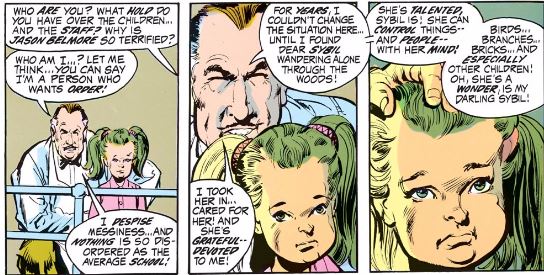
NA: Yes, well, they were not Nixon and Agnew please. The ugliest little girl in comic books -- Richard Nixon. [Laughs] We got a letter from the governor of Florida who wrote a letter that said "How dare you insult the Vice President of the United States like that! That's the most outrageous thing I ever seen in a comic book. It will ruin children's minds. If you ever do such a thing again, I will see to it that DC Comics are not distributed in the state of Florida. So the governor sent a letter and the executives that owned DC at that time, I forget -- they were funeral owners or whatever -- they came to see me, because Denny wasn't there, because Denny was rarely in the studio, and they said "Look at this letter" and handed me the letter. But of course I resisted breaking out in laughter. I said "Yeah, I noticed they didn't notice that the little girl is Richard Nixon", who again was the ugliest little girl in comic books. "She was?" "Yes, she was." Apparently they didn't notice that. They said "Well, what are we going to do about this?" I said "Well, I guess we're not going to do it again." [rich laughter] You idiots.
AWW: In the same issue that you introduced John Stewart you also did a Green Arrow back-up feature written by Elliot S. Maggin. ["What Good Can One Man Do?" featured Oliver Queen considering an offer to run for mayor of Star City.]
NA: Yes, yes, that's right. And I lost some pages of that and had to do them again, did them in pencil. I think I helped Elliot get started in his career with that little story.
AWW: That mayoral storyline for Green Arrow is still going on, because he's running for mayor in the TV show now.
NA: Funny about that. We call it the Neal Adams show.
Listen to a sound clip of the next section.
AWW: They also have -- however, you feel like pronouncing it Ra's [Rahz or Raysh] al Ghul. [Ra's Al Ghul, the 1970s Batman villain co-created by Neal Adams, has had his name pronounced different ways The 1990s Batman: The Animated Series used the Raysh pronunciation. On the Arrow TV show, characters use either pronunciation.]
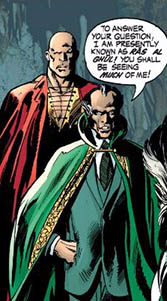 NA: Well, I don't think you can pronounce it Raysh unless it's spelled Rasch. But R, A, Apostrophe, S spells Ra's. In English. Unless that's Arabic and it's not. Rahz. I think it's funny that people try to make something of this thing. You know, it's like it's a Croissant. Now, it's spelled crescent. Just in France is it a croissant. In America, it's a crescent roll. I'm sorry. I know you want to say croissant. But it's not a croissant. It's a crescent roll. But if you're in France, you can say croissant. But no, this is Ra's al Ghul. R, A, Apostrophe, S. There's no other way to pronounce it, except for Rahz. Raysh -- I don't know where you get the extra letters to say that, unless you're affected. You're hanging around Greenwich Village and well, we're trying to be a little bit literate here. I read Tolstoy and it's Raysh -- Raysh al Ghul. Yeah, okay, fine, if that's what you want. But it's spelled R, A, apostrophe, S, sorry. I had an Arab kid come to a convention, like 16 or 17 years old, and we're talking and it turns he's an Arab and we had a nice little chat. And I said "Wait a second, hold on, Ra's al Ghul - R, A, Apostrophe, S, how's that pronounced?" And he said "Ra's al Ghul." I said "You mean, it's not Raysh?" He says "Why would it be Raysh?" That's stupid. "You're from Saudia Arabia, right?" "Yeah. It's not. It's the head of the demon. It's Ra's. Unless you spell things differently here." "No, we don't. Thank you." These little experiences make life delightful. NA: Well, I don't think you can pronounce it Raysh unless it's spelled Rasch. But R, A, Apostrophe, S spells Ra's. In English. Unless that's Arabic and it's not. Rahz. I think it's funny that people try to make something of this thing. You know, it's like it's a Croissant. Now, it's spelled crescent. Just in France is it a croissant. In America, it's a crescent roll. I'm sorry. I know you want to say croissant. But it's not a croissant. It's a crescent roll. But if you're in France, you can say croissant. But no, this is Ra's al Ghul. R, A, Apostrophe, S. There's no other way to pronounce it, except for Rahz. Raysh -- I don't know where you get the extra letters to say that, unless you're affected. You're hanging around Greenwich Village and well, we're trying to be a little bit literate here. I read Tolstoy and it's Raysh -- Raysh al Ghul. Yeah, okay, fine, if that's what you want. But it's spelled R, A, apostrophe, S, sorry. I had an Arab kid come to a convention, like 16 or 17 years old, and we're talking and it turns he's an Arab and we had a nice little chat. And I said "Wait a second, hold on, Ra's al Ghul - R, A, Apostrophe, S, how's that pronounced?" And he said "Ra's al Ghul." I said "You mean, it's not Raysh?" He says "Why would it be Raysh?" That's stupid. "You're from Saudia Arabia, right?" "Yeah. It's not. It's the head of the demon. It's Ra's. Unless you spell things differently here." "No, we don't. Thank you." These little experiences make life delightful.
AWW: It was odd to see him on Arrow though.
NA: No, it's not odd. What happened is that the guys on that show just followed Denny's and my stuff and they're just taking anything they can, and you know turning it into the show. I mean that's what you do, you know. What else is there that's good that you can do that with? And it's turned into a good show. All that stuff, they're mixing it around. It's almost like they were doing a continuation of what Denny and I did. Only you know, they'll grab stuff from Batman. So what? How's going to stop them? They've got a successful show. Everybody's happy. No problems. And am I insulted? No! I mean three or four shows ago they said "Ah, we found out that so-and-so is Neal Adams. No, Neal Adams is old and bald. No, it was short and bald. And they dismissed him. Yeah? Yeah? Catch you boys in the alley, and show you how short I am.
AWW: The run with Green Arrow ends with the story with the plane, where Green Lantern becomes more of the rebel and Green Arrow questions the radical in the story as being too radical.
NA: Exactly. "Send me a bill." It's good stuff. I would say that that's one of Denny's best jobs. That one. Yeah, kicked ass. And it got you in the throat too. The guy [Isaac - the issue's Biblical-styled eco-terrorist] dies and that bird flies away? Whoa.
AWW: The Green Lantern/Green Arrow run that you did with Denny O'Neil is still better written and better drawn than most comics I've ever seen.
NA: That's right. And they're doing this new deluxe edition [Absolute Edition] of the run and they're selling it for a hundred bucks or whatever because it's bigger. They keep on redoing, reprinting it and reprinting it every couple of years, and the price keeps going on up. Soon it's going to be the Gutenberg Bible.
AWW: They even reprinted it when you were still working on the comic, didn't they? In black-and-white paperbacks.
NA: Sure, absolutely. Little pocket books. No, it's been printed a number of times. They put two books in one book and then charged more money. And then put them in two books. And then put them together in a hardcover. And then black-and-white, with a hardcover all in colour. They did a slipcase. I remember when they did the slipcase, it was about, oh, ten years ago. They slipcased it, printed it in colour and they offered it for seventy-five bucks. And the dealers felt that's too much to charge. So they took a limited number of copies, and people went in and a lot of dealers discounted it to forty bucks, figuring "Well, this thing isn't going to sell unless we take it to 40 bucks." And they lost half their stock within a day or two, and they realized "this is not a good idea" and it went back up to $70. This was stupid. And so that thing basically sold out and has been out of print for, I would say, six years now. There's softcovers and such, but that thing is sought after. If you want to get a copy, it will cost you 400 bucks on the Internet. On that hardcover edition they made half a million bucks. You can do the math. 15,000 copies at 75 bucks a piece, publisher keeps half that money. Figure out what that is, it's pretty good.
AWW: In a way, you're revisiting several of the iconic covers of that era this month.
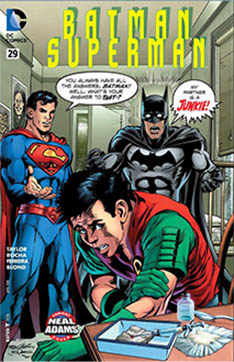 NA: They said "Neal, how would you like to do like 25 iconic covers of this famous artist who has done lots of covers for us?" I said "well, who's the artist?" They said "You." "No, no, that's stupid, you don't want to do that." They said "No, no, we want to do that" and they said "What we'll do is you'll pencil the covers and each one will be inked by somebody else." I said "Really?" "But no, you're not just going to do the covers, the characters on the covers are going to be different characters. So, you know, it's not the Joker holding a card with Batman on it, it's Black Manta holding Aquaman on a card. It's not going to be Superman throwing Batman off a building it's going to be Wonder Woman throwing Superman off a building for the Wonder Woman book." I said "You really want to do that?" They said "Yeah." I said "if you pay me, I'll do it." Not only that I realized as I got into it that they were the same compositions, I didn't have to create a new layout. I just skipped over the layout part and right to pencilling on the covers. So, I did pretty good for like that week and a half. And they got 25 or 28 covers, somethng like that. Pretty crazy. And lots of people - Kevin Nowlan inked three, [Brian] Bolland inked one, Jim Lee inked one, Frank Miller inked one, Walt Simonson inked one, Brent Anderson inked one. It's great. It looks fantastic. It seemed like a stupid idea. Sort of like Superman vs. Muhammad Ali seemed like a stupid idea. No, it's not. Apparently it's not. The first bunch of covers are in stores right now. NA: They said "Neal, how would you like to do like 25 iconic covers of this famous artist who has done lots of covers for us?" I said "well, who's the artist?" They said "You." "No, no, that's stupid, you don't want to do that." They said "No, no, we want to do that" and they said "What we'll do is you'll pencil the covers and each one will be inked by somebody else." I said "Really?" "But no, you're not just going to do the covers, the characters on the covers are going to be different characters. So, you know, it's not the Joker holding a card with Batman on it, it's Black Manta holding Aquaman on a card. It's not going to be Superman throwing Batman off a building it's going to be Wonder Woman throwing Superman off a building for the Wonder Woman book." I said "You really want to do that?" They said "Yeah." I said "if you pay me, I'll do it." Not only that I realized as I got into it that they were the same compositions, I didn't have to create a new layout. I just skipped over the layout part and right to pencilling on the covers. So, I did pretty good for like that week and a half. And they got 25 or 28 covers, somethng like that. Pretty crazy. And lots of people - Kevin Nowlan inked three, [Brian] Bolland inked one, Jim Lee inked one, Frank Miller inked one, Walt Simonson inked one, Brent Anderson inked one. It's great. It looks fantastic. It seemed like a stupid idea. Sort of like Superman vs. Muhammad Ali seemed like a stupid idea. No, it's not. Apparently it's not. The first bunch of covers are in stores right now.
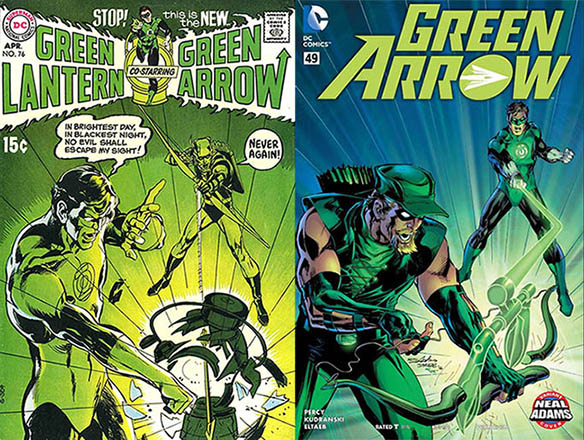
AWW: When you did the Green Arrow cover [homaging Green Lantern #76, but switching the position of the characters] you changed Green Arrow's hat, moved it away from the Robin Hood hat.
NA: That's actually kind of a backstory. You've watched the TV show and you've seen these hoods that the guys are wearing, right? Now if you were an archer and you wanted to shoot and you had a hood on and you turned your head to shoot, you wouldn't be able to see. You can't see with a hood on. Stupid. Just put your hand up to the side of your face and turn left. Your eye goes right to your hand. You have to really twist yourself around and yank the hood to be able to do that. It was a stupid idea to begin. It's a flavourful idea, because of hoodies now and all that stuff. But hoodies aren't like those hoods. Hoodies just go on your head. They don't stick out in front of your face or hide your face. So I've had kind of a running dialogue with the guys on the show, and I've admitted to them that you can't put a Robin Hood hat on Green Arrow because it just looks silly. So, the hoodie was sort of a -- I think Mike Grell came up with it.
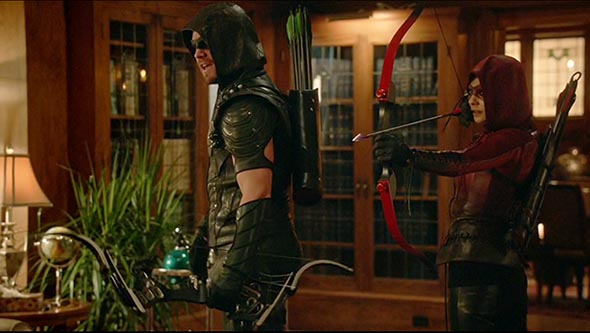
AWW: In the Longbow Hunters. Apparently it was to keep the rain off in Seattle. [In the 1987 mini-series, Green Arrow: The Longbow Hunters, writer/artist Mike Grell relocated Green Arrow from the fictional Star City to Seattle and changed his costume from Neal Adams' design.]
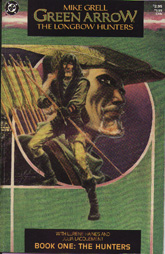 NA: He also did blousey sleeves on him. Blousey sleeves on a shirt, which is like ... ask an archer if he should wear blousy sleeves and shoot a bow. Not a good idea. Not a good idea. That's a very bad idea. Can you put a hood on? Mmmmm... not a good idea. These are not good ideas, but they're doing them in the show because that Green Arrow's the most lasting. But you can't go back to the Robin Hood thing but I had some exchanges with the fellas doing the show, and I said you know, there's certain Russian hats and German hats that look not like our baseball caps, but would make a very good hat, and if you put it on, you'd say that's a very interesting hat, it's a cap. You know, it's more like a German hat. Because it has a nice style to it. But it's not the Robin Hood hat, but then again it's not a hoodie. So, you might want to think about that. So, I put it on the drawing. NA: He also did blousey sleeves on him. Blousey sleeves on a shirt, which is like ... ask an archer if he should wear blousy sleeves and shoot a bow. Not a good idea. Not a good idea. That's a very bad idea. Can you put a hood on? Mmmmm... not a good idea. These are not good ideas, but they're doing them in the show because that Green Arrow's the most lasting. But you can't go back to the Robin Hood thing but I had some exchanges with the fellas doing the show, and I said you know, there's certain Russian hats and German hats that look not like our baseball caps, but would make a very good hat, and if you put it on, you'd say that's a very interesting hat, it's a cap. You know, it's more like a German hat. Because it has a nice style to it. But it's not the Robin Hood hat, but then again it's not a hoodie. So, you might want to think about that. So, I put it on the drawing.
AWW: And that was a message.
NA: Hint, hint, hint.
AWW: I also understand with Arrow you had some issues with the first season with him killing people, which you and Denny O'Neil addressed in the issues with him accidentally killing someone at the very end of your run when you moved to Flash. [After the original Green Lantern/Green Arrow run, it moved to the Flash comic as a back-up feature. After a three-part story, it became a Green Lantern solo backup with Green Arrow as the back-up feature in Action Comics.]
NA: I don't think that was Denny. It was Len Wein, wasn't it?
AWW: The collected editions still credit it to Denny O'Neil.
NA: I don't know... I didn't like doing that. But he does it by accident right?
AWW: Yeah, his arm is injured.
NA: If I was Green Arrow, I wouldn't have done that. I wouldn't have taken the shot. Nor do I agree with it. But I did it because I'm a good guy. When I was at the San Diego Comic-Con, after the first season, the writers of the show came over to my table and introduced themselves. He said "I'm the head writer on the show". I said "cool", and he introduced the other two writers that were there. I said that's great. And he said "What do you think of the show?" I said "Well, so this is where I bulls--t you and tell you I love it, blah-blah-blah. He says "No, no, I really want -- " I said "Nah, you just want me to bulls--t you, right?" He said "No. What do you think?" I said "Okay, if you're really asking me I'm gonna tell you." He said "Yeah." I said "Green Arrow doesn't fire an arrow in someone's f---ing heart and kill them. Hello? Knock, knock. He's got these trick arrows that do this stuff. They don't have - for the most part - points. Well, you've got points on some if you want to pin somebody against the wall or cut a cable or something. But you don't kill people with the bow and arrow! That's like -- no! It's a no-no. We don't do that. It's wrong."
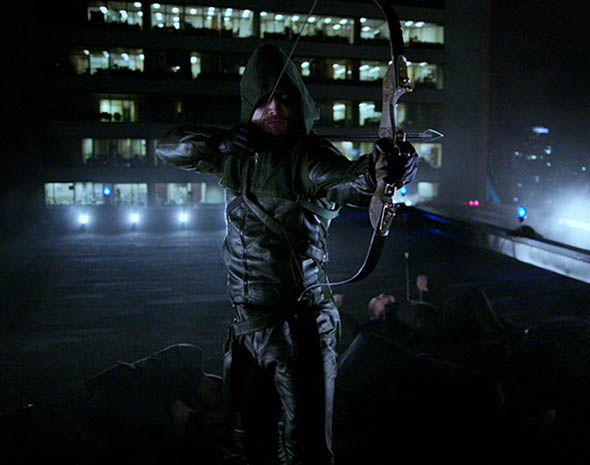
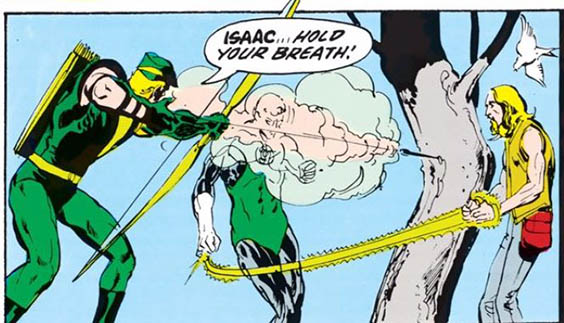
So he says "Next season, guess what?" I said "What?" "We're not going to kill anybody." "All right! All right! Good! Hey, reading the comic books!" He says "Yeah. We get it." I said "Cool." He said "Anything else?" I said "Well, you could put a smile on his face once in a while! Damnit." "Ah, I guess we'll lead up to that." He says "But you're going to see lots of characters you recognize coming aboard." I said "Oh really?" "Yeah." So, we've kind of kept up a little correspondence. I sent him some concepts and ideas. They ignore them.
AWW: Didn't you work on the issue of Justice League where they introduced Merlyn? You drew some of it along with Dick Dillin.
NA: I drew some of it and I introduced Merlyn. [The character has been adapted for the TV series as Malcolm Merlyn, the Dark Archer, played by John Barrowman.] That was like "Why are you guys asking me to do this?" "Well, because you've done Green Arrow, Green Lantern. Can you do this? We'd like you to introduce the character?" I said "So you think I'm going to do such a great job it's going to blow the comic book off the stands?" "Well, maybe." I think it's like one page. Maybe there are other pages, but there's one page where I introduce Merlyn. So essentially I created Merlyn in one page and they asked me to.
AWW: So, you designed the look of the character.
NA: That's right.
AWW: And he was tied in with the League of Assassins, which started with Deadman.
NA: Thank you for reading comic books, my friend! Yes indeed. That's where the League of Assassins began. I mean sure they began before that historically but that's where they were first introduced and I created those. Nanda Parbat, all that stuff. [Neal Adams drew the Deadman feature with the character's second appearance in Strange Adventures #206, cover-dated November 1967. He later took over writing, and what was originally called the Society of Assassins was introduced in Strange Adventures #215 in December 1968 along with the land Nanda Parbat. The characters were later tied in with Ra's al Ghul from Denny O'Neil and Neal Adams Batman comics and have been featured in the Arrow television series.]
Those guys must be reading my comic books pretty heavily. "Where are we going to put this?" "Nanda Parbat." "What is that?" "It's in the Himalayas." "That's cool. How are we going to get there?" "Doesn't matter. Teleport." "Up in the mountains, you know what we oughta have? We oughta have Green Arrow swordfight with Ra's al Ghul." "Swordfight?" "Yeah, on top of a mountain, we're not close enough to a desert. We have to put them on top of a mountain." "Green Arrow doesn't swordfight. He's got a bow and arrow." "Doesn't matter. Have them take their shirts off and fight. Just like in Batman." When that preview came on and they kept on showing the swordfight, I thought "Is everybody seeing this?" And they get it. And then I heard on an interview they had on the Internet with the writers there that "Of course we stole it! What do you think? The only thing was we were in Vancouver and couldn't get to a desert, or we would have shot it in a desert." But no, every bit was taken in that swordfight. [Arrow's swordfight in third season episode "The Climb" was heavily inspired by Batman's swordfight with Ra's al Ghul in Batman #244, cover dated September 1972 by Denny O'Neil and Neal Adams.]
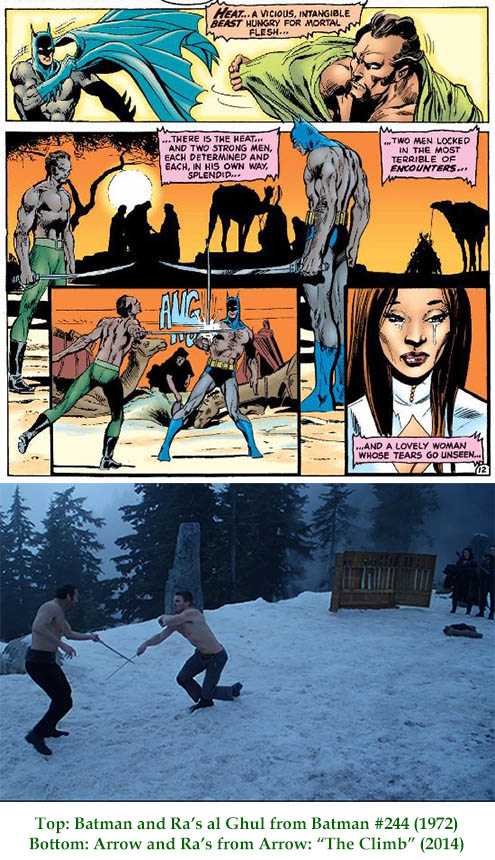
AWW: Wasn't there a lot of talk when you did that originally in the comics about showing Batman's chest hair?
NA: Look it, I did the cover of that book and there are three things notable on that cover. First that he's got two pair of pants. One pair of pants on, and one hanging from the hand of Ra's al Ghul. Two pair of pants? How do you get two pair of pants? What was that? Now you've got to go to your collection and say "Really?" Yeah, we coloured his legs like pants because in order to take his pants off, you'd have to take his trunks off, and then he would be naked. See? And Julie said, "No, no, colour his legs grey." "Okay, I'll colour his legs grey, just to make you happy, Julie." The second thing was, he got matted hair all over his chest. Like crazy. And nipples. This is something you don't know, but that's the first time in comic books ever that nipples have appeared on a man.
AWW: Really?
NA: Yeah, historically. Now there may be some pretty obscure place where somebody put nipples but not that I know of. And guys that take their shirts off, they would be nippleless. "Superman, you have no nipples on. Okay, you're an alien, I get it." But no, no nipples and no chest hair. I mean, as far I know, I have nipples and chest hair. But that's the first time. People talk about the chest hair, it's the nipples. That's the thing. But it created a sensation. "Oh my God, can we do that?" "Why not, it's normal?" You know, it's a weird business to be in. And to do the s--t that you do because it's so crazy. Superman vs. Muhammad Ali? You can do that? Yes. Nipples? Holy cow, what kind of repressed, weird industry are we in?
AWW: Or back to the skin colour of John Stewart.
NA: Exactly. "Black people have dark skin?" "Yes, they have dark skin, and they have flat noses and their lips come out as far as their noses. That's the way Black people are. Hello?" That's the way it works. Black is beautiful, you ever hear that phrase? Well, there's a real reason for it being. They're different, but beautiful. And that's the whole point of the thing. Which they say "Their lips come out as far their noses?" "Yes, look at a profile. Almost every Black person you ever met. Except for those announcers on TV, where'd they come from? I have much too much fun doing this. They're about to change what is it, Scooby-Doo? Over at DC they have the license to it?
AWW: Yes, I think they've given Shaggy your Green Arrow beard.
NA: [Laughs] Jim Lee's got a cover in here, and I've got a cover in Scooby-Doo and everyone's going "what? That's not Scooby-Doo." "Yes, it is. It's Scooby-Doo, but realistic." I'm going to do a cover just to contribute to the insult.
AWW: And you're doing Superman again. Well, I say again but aside from covers, a couple issues and Superman vs Muhammad Ali, this is one of the few times where you're doing an extended story with the character.
NA: Well, that Superman [in 1978's Superman vs. Muhammad Ali] I tried to follow a standard Superman to do that. The Superman I'm doing now is is a little different. Not that different, but a little different in that he's handsome enough to fall in love with and he's got enough anatomy to go around. And in Superman vs. Muhammad Ali, it was, you know, Curt Swan's Superman a little trimmer but fine. [Curt Swan was the dominant Superman artist from the late 1950s until the mid-1980s.] This is similar. But it's how you remember Superman. Somehow I'm trying to do the Superman within your brain. You know, this really powerful Superman who is good-looking and got a curl on his forehead and s--t like that? That's the Superman I'm trying to do. Is that any different from Superman? I don't think so.
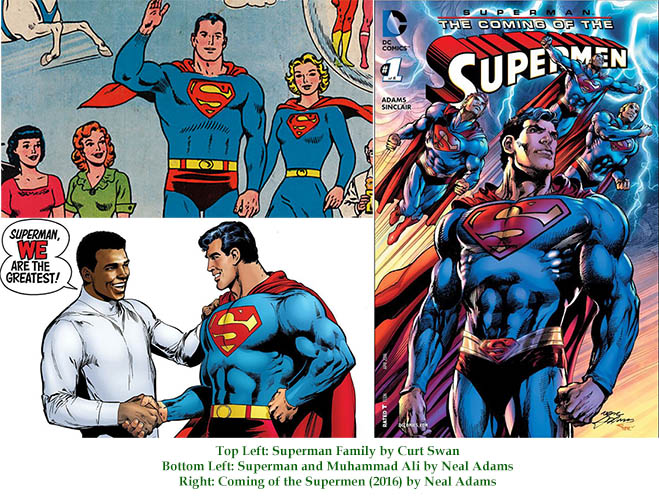
One of the things that people say is that I changed Batman and made him into the modern Batman. You know, the Dark Knight and the cape flowing. And all the other stuff. Trim and athletic. "I changed Batman." No, I didn't. I didn't change Batman at all. I just did the Batman that Jerry Robinson did, only I draw it better. [Jerry Robinson was an early ghost artist for Batman co-creator Bob Kane. Robinson created the Joker and Robin the Boy Wonder.] And that's all. I didn't change Batman at all. I even gave him later on the Batman symbol on his chest that didn't have the moon around it so it would make a target for people to shoot at. That was weird. Carmine did that, I think -- put the thing around. [When Batman was introduced in 1939, his chest symbol was a black bat. In 1964 artist Carmine Infantino put a yellow circle around the bat symbol. When Neal Adams revisited Batman in the 2010 series Batman Odyssey, he drew the character without the yellow circle.] "Carmine, it's a target. People are going to kill him." "No, they don't see it. Just cover it up with his cape." "No, it's yellow. Sorry, f---ing yellow." Really? If somebody wore something yellow, I would see it. Anyway, so I didn't really change Batman. I mean people give me an awful lot of credit for changing Batman. I didn't really change Batman at all. I made him what he was, only just a little better drawn.
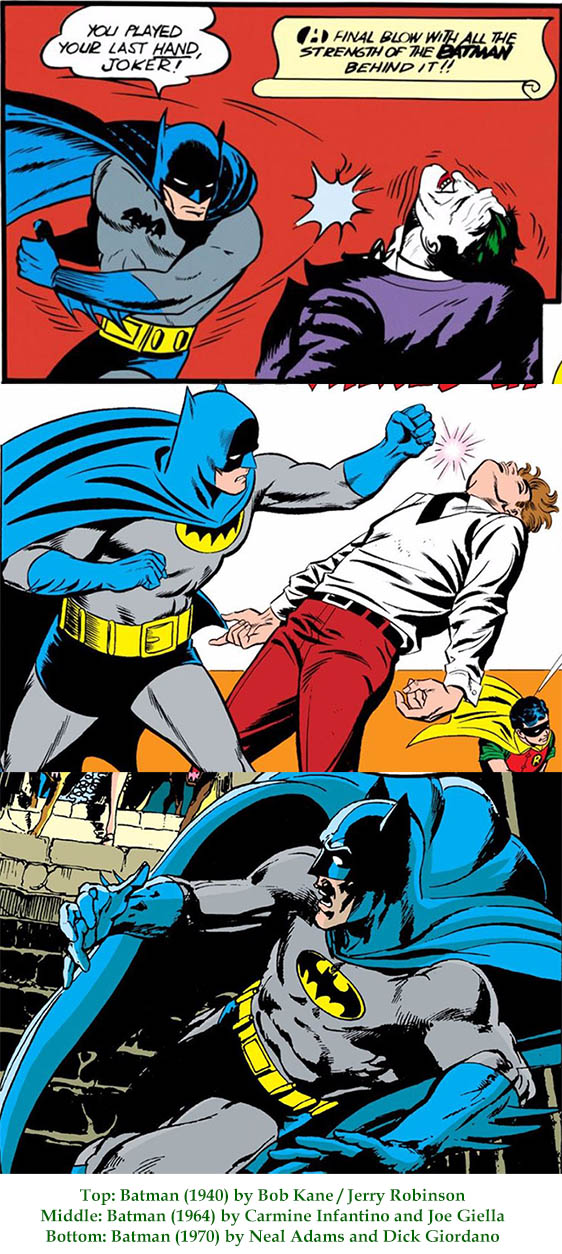
Click here to listen to an audio clip of the following section.
So that's sort of what I'm doing with Superman now. I'm making Superman better. I'm not making him different. I'm not, you know, putting him in a t-shirt and jeans. He's wearing his Superman outfit. The belt is a little different because I think he needs a good belt. He's still wearing the trunks on the outside of the pants in my Superman. Got an S on his chest got a cape. It looks like Superman. And that's the Superman we know and love. And as far I'm concerned it's your Superman or my Superman, he's the Superman we've grown up with. And I like that character.
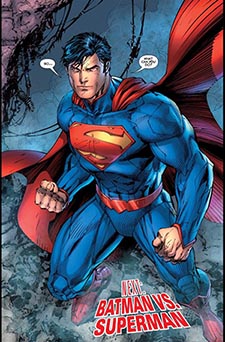 They keep on messing with him. You know they got a Superman in the movies that's got armour on. What does he need it for? He's the Man of Steel. Hello? Or in the comic books, he's got a collar? That goes up his neck, right? Sort of like a West Point collar? If Clark Kent puts his shirt on, don't you see that sticking above it? Really? And the sleeves come out and then they push past his wrists onto back of his hands, so Clark Kent not only can't roll up his sleeves, but when he reaches for something the Superman costume comes out. [The 2011 costume designed by Jim Lee.] You know, we were able to forgive that for a long time but now it's like ... whoa. Weird. And when Superman has to pee, is there a zipper in the front? I don't think so. I'm just saying. So I'm dealing with it, you know. I really don't swing at high balls. I swing at low balls. But I usually connect. They keep on messing with him. You know they got a Superman in the movies that's got armour on. What does he need it for? He's the Man of Steel. Hello? Or in the comic books, he's got a collar? That goes up his neck, right? Sort of like a West Point collar? If Clark Kent puts his shirt on, don't you see that sticking above it? Really? And the sleeves come out and then they push past his wrists onto back of his hands, so Clark Kent not only can't roll up his sleeves, but when he reaches for something the Superman costume comes out. [The 2011 costume designed by Jim Lee.] You know, we were able to forgive that for a long time but now it's like ... whoa. Weird. And when Superman has to pee, is there a zipper in the front? I don't think so. I'm just saying. So I'm dealing with it, you know. I really don't swing at high balls. I swing at low balls. But I usually connect.
I have a Superman cover right in front of me where I have Superman holding Luthor and Darkseid apart and they are trying to kill each other and Luthor is heavy. He looks like Luthor. I remember Luthor - he was chunky and had that thick neck and jowls. And he wasn't handsome and attractive. And he was bald. I have a scene where Luthor's trying to take blood from these different Supermen, and Superman is destroying his machinery and s--t, and telling him there are certain things he can't do. Luthor says "I'm going to sue you", and Superman says "I got a paper trail on you that's as long as my arm, and if anybody's going to do any suing, I'm going to sue you." And then Luthor says "You know, I really hate your hair." [Laughs]
AWW: When does that come out?
NA: The first issue comes out this month [February 2016]. And it's got a boy and his dog. There's a little Muslim, Arab kid -- "A Muslim, Arab kid? Neal! What are you doing?" Maybe Superman's going to adopt him. The kid doesn't have any fun, and they don't like his dog where he lives.
AWW: I guess today no one would give you the trouble like they did back in the early 70s?
NA: Oh, they give me trouble. Are you kidding? I did a cover a few years ago where I had Superman in front of this Muslim kid and his dog, and there's a bomb going off right behind Superman and he's shielding the kid with his cape and himself. And it's a cover, right? And I submitted it to DC Comics because I thought it would be easy to write a story for it, and they didn't reject it, but they didn't accept it. You know what I mean? "Oh, this is good. I don't know if we can use this. Maybe later. Umm, we'll talk about it later." [Laughs] So I made it the theme of the story. Ah, s--t. [Laughs again]
AWW: I'm looking forward to that.
NA: Me too. I'm having a great time. I got Kalibak, I got all the characters, Granny Goodness.
[Characters by artist/writer Jack Kirby, For those who don't know, Jack Kirby had a long career in comic books. He's best known for his Marvel Comics worked where he co-created (with Joe Simon) Captain America in 1941 and in the 1960s with Stan Lee co-created the Fantastic Four, the Hulk, the X-Men and the Avengers. He illustrated Green Arrow in the late 1950s, drawing the story revamped Green Arrow's origin to the Robinson Crusoe-like story still used today. In late 1970 Kirby left Marvel for DC Comics once again and created a sci-fi mythology across four different comic book series. These comics featured the struggle of the heroic New Gods from the planet New Genesis against the evil tyrant Darkseid, ruler of Apokolips. Kirby first introduced these characters in an issue of Superman's Pal Jimmy Olsen. Darkseid and his henchmen, including his son Kalibak and Granny Goodness, have often been incorporated into the Superman storyline by later writers and artists.]
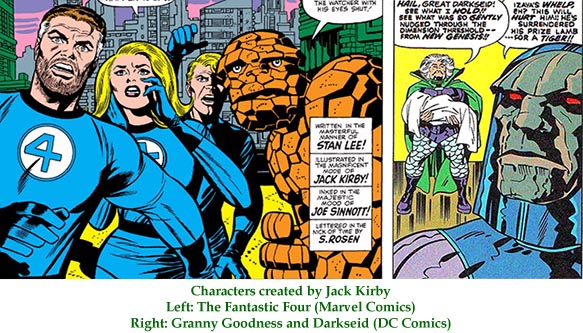
AWW: Are you doing them in Neal Adams style or a fusion with Jack Kirby?
NA: Well, when I do Jack Kirby's stuff I tried to thrown as much of Jack Kirby. Okay, let's be honest between you and me and the fencepost. Jack wasn't what you call a draftsman. Not really a good drawer-er-er. You know what I'm saying? He was a great comic book artist, a great creator, did lots of stuff fantastically well, but it took somebody like [inker] Joe Sinnott to clean it up and make it a little less, you know, teeth looking like giant Chiclets and s--t like that. So, if I do it, the question is what then do I do with Jack Kirby's stuff. Well, I find excuses to do more Jack Kirby when I'm doing Jack Kirby stuff than other guys do. Other guys clean it up and the make it, you know, more brilliantine. I try to make it as Jack Kirby as I can. And so I'm having the damnest time doing Kalibak and all these characters. And they look like Jack Kirby. You would say if you look at it, you'd say well, you know, maybe a little better drawn, but it's Kirby. It's Kirby's characters. That's the goal I'm trying to do. You know, we always kind of like Jack when the stuff is drawn a little bit better, and it's a little bit neater and a little bit cleaner -- and it gets a chance to slow down and maybe not do maybe five pages a day and can do two to three pages a day. And he can put more into them.
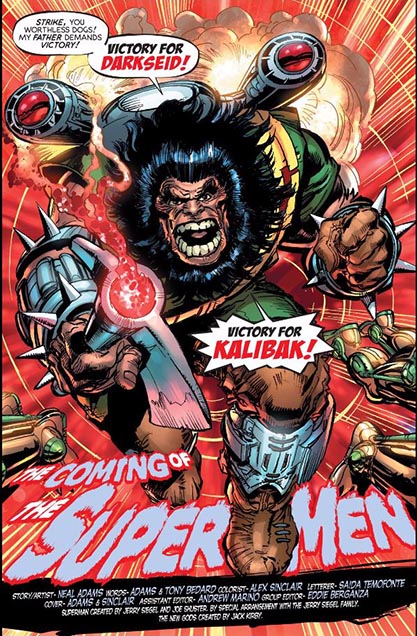
So I'm trying to do the best of Kirby and not the least of Kirby, but I'm keeping the Kirby. I'm not changing the costumes, I'm not changing the faces, as soon as you see Granny Goodness you say "Oh, it's Granny Goodness." "It's Kalibak, jumping out of the Boom Tube right in your face." And the costumes are the same. I'm keeping everything the same. I'm too lazy to change it anyway. Too many guys are changing the stuff when they don't need to change it. Obviously he had reasons to doing the costumes the way he did. So why screw with them? I keep them. It's Kirby. It's my turn on Kirby and it's only a matter of draftsmanship. It's not a matter of not doing an homage. It's all homagey. It's homagey everywhere. I got Darkseid right here screaming at Luthor. And Luthor is Curt Swan's Luthor and Darkseid is Jack Kirby's Darkseid. Never the twain shall meet. It's just that muscles are in the right place a little bit more, know what I mean?
AWW: That's one of the things you're famous for, the photorealistic style.
NA: I would say that I tip more toward Kirby in this because you do have to do some of these bold, slashy Jack Kirby lines, nice big blacks, clunky muscles and s--t, big chompers -- those big teeth that don't seem to fit into anybody's mouth. Yeah, I do that. But I know how to do that. You see, I started out as a cartoonist -- a big foot cartoonist. What they call big foot. Big foot is a cartoon, characters with big feet. A little foot artist is a person who draws like superheroes and they have little tiny feet. That's the difference between big foot and little foot. You just learned something. And I started out doing kind of big foot stuff. Sort of cartoony. And I liked doing that. But then I realized I could draw better so I started drawing realistic stuff, but I never lost the cartoony aspect of it. So I can bend toward cartoony, and Jack Kirby's stuff is a little bit more cartoony than my stuff, so I can just go there. It's not hardened. I don't have any religious beliefs in any of this bulls--t.
AWW: And with that cartoonist background you can adapt to Kirby better than other comic artists can.
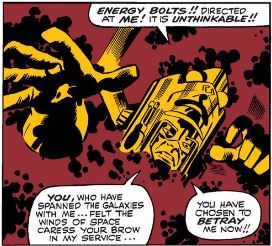 NA: Oh sure. I've seen it. I see other people and they just can escape their own desire to change s--t. I don't have that desire. Like when I did Batman. You could say "What did you do to Batman?" "I didn't do anything." "Yeah, but it looked different." "Yeah, everybody who drew Batman looked different, didn't they? But it's still Batman." I'm not trying to make him bulky or anything. He just looks a little bit more athletic and his cape flows better, but it's still Batman. Everything's the same. I didn't change it at all. I'm not changing Superman. And I'm trying my damnest not to change Jack Kirby. Why should I change Jack Kirby? The other thing too is like you can sit around artists all the time and say "Boy, would I like to do Kirby." As soon as I would say I'm doing Jack Kirby "Can I ink some?" "Can I ink some?" "Are you doing those lines?" "Yeah, I'm doing those lines." "Oh really, can I ink some?" Because you look at that Kirby stuff and you go "Yeah, you don't even have to use a pen, you can use a big brush - plop - and blow in those lines. As soon as you say it, everyone wants to do those lines. Kirby lines. And Kirby energy. You know all those dots? Kirby energy! Sure, that's great. Kalibak is loaded with Kirby energy. It's coming out of that battle axe he has - choom! -- Kirby energy. I'm just having a great time. I'm keeping the faith with Jack. And I wish other people would too, you know. Maybe, we could get back to... You know, within everybody's style is the ability to do Jack Kirby's stuff. As long as you don't change it. You can do it in your own style but don't change it. Don't put a different outfit on the character because you happen to like that or you think you're a better artist or you know more than Jack Kirby knew. You don't know more than Jack Kirby knew. Don't put a skirt on this character that doesn't deserve a skirt. Don't change it. And people do. NA: Oh sure. I've seen it. I see other people and they just can escape their own desire to change s--t. I don't have that desire. Like when I did Batman. You could say "What did you do to Batman?" "I didn't do anything." "Yeah, but it looked different." "Yeah, everybody who drew Batman looked different, didn't they? But it's still Batman." I'm not trying to make him bulky or anything. He just looks a little bit more athletic and his cape flows better, but it's still Batman. Everything's the same. I didn't change it at all. I'm not changing Superman. And I'm trying my damnest not to change Jack Kirby. Why should I change Jack Kirby? The other thing too is like you can sit around artists all the time and say "Boy, would I like to do Kirby." As soon as I would say I'm doing Jack Kirby "Can I ink some?" "Can I ink some?" "Are you doing those lines?" "Yeah, I'm doing those lines." "Oh really, can I ink some?" Because you look at that Kirby stuff and you go "Yeah, you don't even have to use a pen, you can use a big brush - plop - and blow in those lines. As soon as you say it, everyone wants to do those lines. Kirby lines. And Kirby energy. You know all those dots? Kirby energy! Sure, that's great. Kalibak is loaded with Kirby energy. It's coming out of that battle axe he has - choom! -- Kirby energy. I'm just having a great time. I'm keeping the faith with Jack. And I wish other people would too, you know. Maybe, we could get back to... You know, within everybody's style is the ability to do Jack Kirby's stuff. As long as you don't change it. You can do it in your own style but don't change it. Don't put a different outfit on the character because you happen to like that or you think you're a better artist or you know more than Jack Kirby knew. You don't know more than Jack Kirby knew. Don't put a skirt on this character that doesn't deserve a skirt. Don't change it. And people do.
I see it all the time. I don't know why. I have characters that I create that people change. And I'm like "Why did you change that? I don't understand." I'm not fighting for it. I'm just saying it's stupid. I create a character called Havok, right? So, I gave him a black costume that absorbed energy -- like they tell you there's black beyond black -- it has no highlights and no outlines, it's just black. And then he has this kind of device on his neck and on his head, where it's around his neck and goes up to his head and then he can use the jewel up there to absorb energy and feed it into his body. And then the black of his body is so black that you see this energy inside and then he can hurl the energy and aim it with this kind of laser thing. And the costume is made to that do. And the first thing people do when they start to the character is to change the costume. Why? Why put all kind of junky s--t on his costume how does he absorb this gamma ray energy in order to fire it out of his body? "Did you read the damned book? Hello?" "No, we're just more creative than you." "Well, you're stupid too." And then they always come back. They come back and "Oh well, we've made Havok the way he was." "Yeah, except you put those bands on his head so he's burning his head when he does the energy s--t." Not a good idea. But yeah, it kinda looks like Havok. Hello? I don't know why they do that.
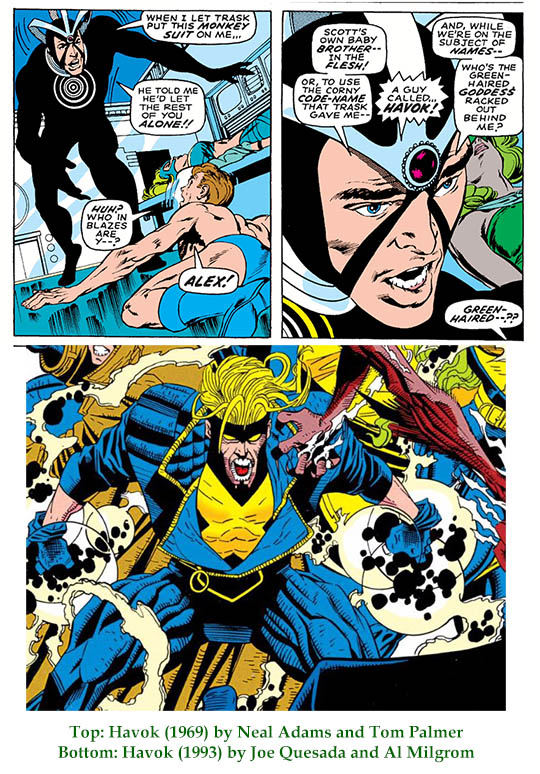
The interview concludes in the next section as Neal Adams shares his thoughts on the recent superhero films and the subject of comic books as art.
AWW: I think it's a trend to say "it's not like your father's or grandfather's whatever."
[Now, the discussion turns to a spoiler-filled conversation of the 2013 film Man of Steel. As with the 1980 film Superman II, the villain is General Zod. Like Superman, Zod is from the planet Krypton (having escaped the planet's destruction because he was locked in an extra-dimensional prison) and posses all of Superman's powers. The film climaxes in a battle that levels much of the city. Superman has Zod in a choke-hold, but the villain is using his heat vision to fire death rays, slowing turning his head so that the beam's threaten an innocent family. To stop Zod, Superman snaps his neck. In previous films, Superman's human foster father Jonathan Kent told his son to use his powers for good. In Man of Steel, Pa Kent castigates his son for saving a bus full of people as it might expose his true identity. Later Pa Kent sacrifices his life when he goes to rescue the family dog, which is trapped in a car in the path of an oncoming tornado. He specifically tells Clark (aka Superman) not to rescue him.]
NA: It goes back to Batman. Why would I change Batman? He's right. Don't change it. You know we've got these changes on Superman. We've got a segmented costume that looks like armour. Because he's the Man of Steel. No, that's not a good idea. That's really not a good idea, is it? He's the Man of Steel. Armour? Nuh-nuh, he doesn't need armour. This last movie they did with Superman was, like, "Oh, he kills a guy at the end." Who'd he kill, Zod? Didn't he already deal with Zod? You mean the first time he was smart enough not to kill him, but this time he's going to kill him and half the people in Metropolis? So, you have to kill him? That's it? You can't put your hand in front of his face when he fires those beams? He can't figure out a way to do it? He can't fight on the moon, the Sahara Desert or some place like that where he doesn't kill half a billion people.
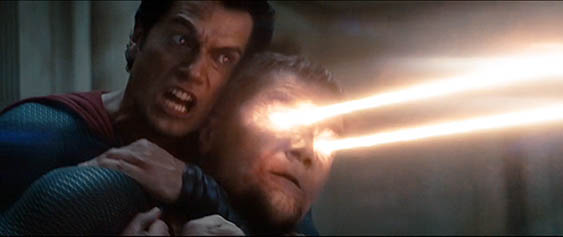
Oh, I know. I know why he kills people. Because his father was crazy. He tells him "Hey, it might have been better to let all those kids in that bus die to protect your identity. That's my advice, son. That's my sage advice being a good American farmer. Protect your identity. Let all the kids die." "Really, dad, really?" Excuse me. "And guess what we got for you? We have found for you the only dog on Earth that stays in the car when the rest of the family leaves." The only dog on Earth. Most dogs the car stops, the dog gets out and runs around in a circle until everybody else gets out and joins him. This dog stays in the car. What the hell was that? Where did they find that dog? I have never seen a dog do that in my life. I've known lots of dogs. They'd be right out of that car, like a rocket. This dog stays in the car. And the father doesn't know that Superman can move like a blur? He doesn't want to be rescued? He wants to f---ing die? You could have the worst dad in the world, you're going to rescue him. You're not going to let him die. He could be f---ing Stalin and you would rescue him if you're his kid, because it's your dad, right? No, this guy has the moral fortitude of a cat. No, he's going to die, I'm staying away. Somebody may see me. No, you move like a blur, kid. Stupid, stupid movie.
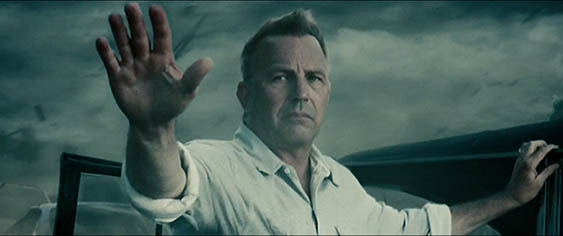
And Zod? His eyes are welded to the back of his head? So, he can only move the beams from his eyes when his head moves? Excuse me? Can't his eyeballs just look over and fry those people? Why did his head have to move? Little steel things coming out of the back of his head, attached to his eyeballs -- that only let his eyes look straight ahead? Is that the deal? And Clark or Superman can't -- let's see, he's got his right arm around his neck, he can put his other hand in front of [Zod's] eyes. No, you don't want to do that, because that's thinking. Stupid s--t.
AWW: It's the same with Green Arrow, they think it's cool to have heroes kill.
NA: When they started it [the TV show Arrow], yeah. But now they're not doing it anymore. They're paying attention to Neal. Pay attention to daddy Neal. "Hey, cut it out." They're doing it right. They're trying to do it. I mean those guys are really making an effort to make a good series. The weird thing is that DC Comics somehow has the good TV series and the lousy movies and Marvel has the good movies and lousy TV series. What the hell is that?
AWW: Are they bringing some of your stuff into the new spinoff Legends of Tomorrow?
NA: Nah, not really. Did you look at the poster and go "who the f--- are these people?" You watch the show and you know who they are, but when you look at the poster, you go "who is that?" I have to put my thinking cap on to really know. It's like that movie Marvel made -- Guardians of the Galaxy, based on the worst comic book on Earth, except maybe for Teenage Mutant Ninja Turtles. The worst comic book I have ever seen from Marvel, and do you know why they made that movie? Because they sold all the other characters!
Marvel used to go around going "we have 2,200 characters" or whatever the number was. No, they didn't! They had nothing! They already sold Spider-Man, they sold Fantastic Four, they sold X-Men -- they sold all their characters. Who'd they have left? The Avengers. That's it. And Guardians of the Galaxy. "A racoon. Hey, guys, let's make something out of it." It's all they had to make anything out of. It's like slicing up the smallest piece of pie on Earth and pretending they're a big company. I don't know what it was with Disney that believed they own their characters, but they didn't own any of them. They got this German company that owned Fantastic Four and they're just acting like clowns. These Germans they're the company that made a movie on Hitler like the good side. Hello? This is not a good company. Constantin, that's right. They're making a Fantastic Four movie so Marvel has said discontinue the comic, to hell with it. Screw it, let's mess with them until they give us back our characters. They're never going to give them back. They'll sell 'em back.
So, they had nothing. Basically what happened was DC Comics kept ahold of the licenses for their characters. Marvel, which is basically Stan Lee all out there by himself, went around Hollywood selling off the rights to the different characters to show his uncle that these were worthwhile properties and that we ought to make movies out of them. Except he made the worst deals in the world. Back in the day, they'd give you $10,000 and they'd own it for 10 years. As long as they made a movie within ten years, they could continue to own it for another 10 years. So they wrote these horrible contracts which DC Comics didn't do because they had lawyers and people with brains. So, they wrote these horrible contracts which seemed good at the time, but when it came time to really do the stuff, all they had left was the Avengers. Everything else was gone. Doctor Strange was part of the Avengers. They basically sold off their lead characters - sold off the X-Men, sold off Spider-Man, sold off Fantastic Four, I mean who's left?
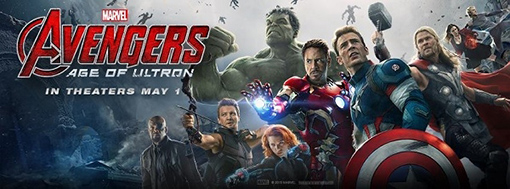
They sold these off and they had the smallest number of characters left. And so they've made the most of them, and in fact they have made the most of them and it's been fantastic. I mean, you've got DC Comics who has a plethora of characters that they can't seem to make a movie out of and you have Marvel who has very few characters, but they seem to have made some of the best movies in Hollywood. Which is amazing, shocking. And they're trying to recapture their characters as much as they can. They have Disney working with them, putting a little pressure on these guys, but the people who bought them know they're worth money. They're not easily going to give them up. So, you can imagine all the kinds of negotiations that's going on with these other companies and Marvel. "Can we use some of our characters as back-up characters?" What's the new one, Deadpool? You've got some X-Men in there. They rented them. "We want to rent some of our characters back." Crazy. Crazy.
AWW: Maybe DC's film division will start borrowing from you the way the TV shows have.
NA: From your mouth to God's ears. God bless you, my boy. Remember when they had um, the Smallville show? They had an actor "I'm never going to wear that costume." Jesus, take him out back and beat the s--t out of him please. Right near the end Granny Goodness showed up and I thought "Oh my God, they're going to do Darkseid" and then they ended the show. Ah, really? Granny Goodness? The show's up. Then they ended it. What a killer.
AWW: I remember Smallville's slogan was "No flights, no tights." The same thing happens with Robin Hood at times -- the shame of certain elements. When a film comes out they say "this time he isn't wearing tights."
NA: Yes, this one makes it different, exactly. Because they're so smart. Brilliant, brilliant people. I don't get it. If you test something and you make sure it works, then don't you take it and do it? Isn't that the smart way to go? I think so. I remember DC Comics would call me, and they casually informed me because there's an excess of enthusiasm, they have to call Neal. And so they call me and said "We think we have an agreement with a Canadian company that's going to make Deadman." "Really, that's interesting. Are they going to pretty much going to do the Deadman we have in the comic book?" "Well, they're going to change it a little bit." "Oh really? And so how are they going to change it?" "Well, first he's not dead." [Laughs] Say no more. Why is he called Deadman? Just, you know. Not dead. Next thing you're going to tell me she's a woman. It's Livewoman. No, it's Deadman. That was a long time ago, 12 years ago or something like that.
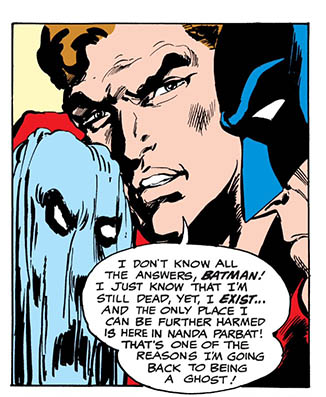
AWW: It's odd because Deadman's one of those properties that could absolutely work. I think there are a lot of DC characters that would work in the mainstream more than they're known in the comics field.
NA: We are the mainstream. Think about it. [In reference to rumours about the plot of the 2015 Oscar-nominated film The Revenant] "Raped by a bear and then he stumbles back into civilization." Ah no, make a superhero movie. That's the mainstream. Getting raped by a bear, that's mainstream? I don't think so. "No, it didn't really rape him. That's bulls--t." Got behind him, felt him up. "I know but somebody said he raped him." That's the only reason Romita watched the movie. Getting raped by a bear, I'd watch that. "Really, you know. How'd he get through the paints?" "Ah, we're not talking about that, what's the matter with you?" It's the mainstream, isn't it? No, I guess not. The X-Men, that's the mainstream. Deadpool, another kind of superhero. That's the mainstream. Let's be honest. What makes the hundreds of millions of dollars in movies? Comic books. We're taking over the world. Get out of the way. Frenchies, you thought it was Asterix and Lieutenant Blueberry? Sorry, it's Superman.[Bad French accent] "Well, we don't zhink Super-duper-man is serious comic, a proper experience for people." I go "Go f--- yourself. We win. You lose."
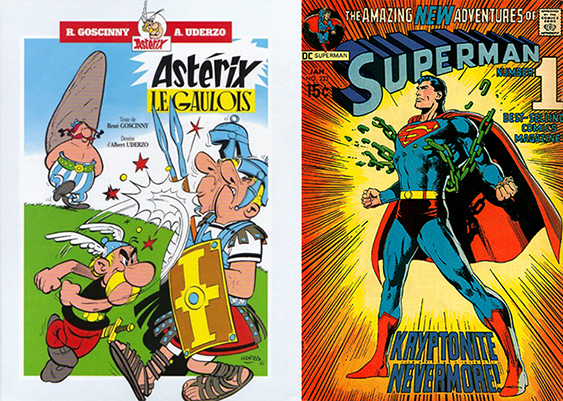
The French believe that America created three forms of art. Of course, they are the French. so whatever they say has to be true. We created jazz, we created the musical comedy and we created the comic books. That's it, just in case you wanted to know the judgment from on high from the French is that's what we did. I mean that's not bad.
I had a guy interview me one time, he came all the way from France with his film crew to interview me. Fortunately I had a soundstage. And the guy pulls out a cigarette and starts to light it, and I say "no, no, no. You can't, you can't, nobody here ... please. You can't smoke. Because people here just leave. Everybody in the studio will leave." [French accent.] "Oh really, I don't is zat not a good thing?" "No, it's not a good thing. And by the way, French cigarettes stink. I'm just saying okay, they will leave and walk out. Why don't we do the interview at the end of the day, then I'll let you smoke the cigarette because I can absorb this foul-smelling crap." So he says okay.
And so we waited until 7 o'clock. And the crew set it up and they lit me from the side. You know, so you get nice shadows on one side, like one of those sexy interviews. The guy sits back and lights up his French cigarette and of course they do stink. It's during the war you know, they got crap cigarettes, they keep on smoking the same s--t all the time. [French accent] "Well, ah, Nealadums" -- my name is apparently one name in France, Nealadums "So, Nealadums, you know that the influence of the comic book on the culture of the world is now changed and you are at the forefront of, and you know this, what do you think your impact on the world market of the comic books is." And I said "You know, you goddamn Frenchies are going to screw up comic books. You screwed up jazz, you're going to screw up musical comedy, and you're going to screw up comic books. Everybody's going to take it seriously and think it's art. And you are going to screw it up. I hate you guys. Why don't you just stop it? Stop this and leave us alone and mind your own business." And he goes "Ah, Nealadums, you are fooling with me, I can tell. Hahaha, very funny." Ah, me. You can't take this stuff too seriously. So, anything else?
AWW: No, thank you very much. That was fantastic. Thanks.
NA: It's a pleasure.
Neal Adams' new comic book series Superman: The Coming of the Supermen is released monthly. The first issue was available in February 2016.
Related Links
Neal Adams can be found on the web at:
If you enjoyed the Neal Adams interview, you might also like:
If you're interested in Green Arrow, you might also enjoy:
Buy Neal Adams and Green Arrow Products
Exclusive signed editions and original art commissions are available at NealAdamsStore.com
Issues of Neal Adams' new series Superman: The Coming of the Supermen are available at your local comic book shop and digitally from Comixology.
See below to purchase Neal Adams and Green Arrow items from Amazon
The Green Lantern / Green Arrow series in three different editions.
Other Comic Books by Neal Adams
The Arrow TV series
The Green Lantern / Green Arrow series in three different editions.
Interview text, © Allen W. Wright, 2016.
Illustrations from Green Lantern / Green Arrow, Batman, The Brave and the Bold, Superman: The Coming of the Supermen, Strange Adventures (Deadman) and Superman vs. Muhammad Ali by Neal Adams, © DC Comics, used without permission as fair use for criticism and review
Illustrations from X-Men and The Fantastic Four/ © Marvel Comics, used without permission as fair use for criticism and review
Pictures from the TV series Arrow and DC's Legends of Tomorrow © Warner Brothers Entertainment (Characters owned by DC Comics), used without permission as fair use for criticism and review
|
